EUROF RUIT








Europe’s tomato business must do everything it can to satisfy new demand for be er taste and flavour, as well as more local and sustainable supply


The European market for fresh tomatoes is expected to grow by 1-3 per cent in the next five years, according to Dutch trade promotion group CBI
Choose any colour, as long as it’s mainly red
Tomatoes, for my money, have the potential to repeat the kind of success seen in Europe over the past decade in the fresh berry category. But I think far more needs to be done in terms of product range and differentiation for that to happen. In most mainstream supermarkets, the job looks only half done. Sure, there are a few colours other than red, some nice nods to snacking and convenience, and perhaps one or two premium-quality lines to draw in those customers who want the finer things in life. But really, if we’re being honest, the range on offer does tend to be dominated by small and medium-sized red varieties. Dare I say it, but it can be rather boring and uninspiring. And I cannot help think that shoppers would leap at the chance to try different colours, different shapes, different sizes. Now, I appreciate that the economics of the food retail business are geared towards satisfying a critical mass of consumers, and for that reason shelf space cannot suddenly be devoted to untested alternatives. But when you see some of the wonderful products that the tomato industry has developed behind the scenes, it seems like such a missed opportunity. Research published by Dutch trade promotion group CBI suggests annual growth in Europe’s fresh tomato market will be 1-3 per cent in the next five years. With a more exciting range of products, I think it could be at least double that. E






Sales
instagram.com/fruitnet
fruitnet.com/berrycongress
The Global Berry Congress brought together leading players in the fresh berry category to connect and share in-depth experience and expertise, whilst exploring new ideas.
Follow Fruitnet's Instagram page for regular photos and updates from the Fruitnet team.

fruitnet.com/eurofruit eurofruit's news website provides regular updates on all the top stories from the European fresh fruit and vegetable business. News


https://desktop.eurofruitmagazine.com
Download the new Eurofruit app onto your smartphone or tablet from the App Store or Google Play. Stay informed of the latest fresh produce industry developments, and enjoy our magazines in new user-friendly digital formats.
linkedin.com/showcase/eurofruitmagazine
Expand your network of professional contacts and join the fresh produce conversation by visiting the eurofruit LinkedIn account. LinkedIn

x.com/eurofruit
Keep up to date with news, opinions and developments from around the European fresh produce trade by following our dedicated X account.
fruitnet.com/freenewsletter
Fruitnet Daily News is the fresh produce industry's leading source of news, information and insight. Available free to all, it is essential reading for those who need to keep track of developments and trends in the international fruit and vegetable business.
https://anchor.fm/fruitbox
Listen to Fruitnet's podcast series hosted by managing director Chris White in London. The Fruitbox podcast features conversations and interviews with leading industry experts. Fruitbox




managing director, fruitnet
europe
Mike Knowles
+44 20 7501 3702 michael@fruitnet.com
managing editor
Maura Maxwell
+44 20 7501 3706 maura@fruitnet.com
deputy editor
Carl Collen
+44 20 7501 3703 carl@fruitnet.com
news editor
Tom Joyce
+44 20 7501 3704 tom@fruitnet.com
staff writer
Fred Searle
+44 20 7501 0301 fred@fruitnet.com
design manager
Simon Spreckley
+44 20 7501 3713 simon@fruitnet.com
senior designer
Qiong Wu
+61 3 9040 1603 wobo@fruitnet.com
senior graphic designer
Mai Luong
+44 20 7501 3713 mai@fruitnet.com
graphic designer
Asma Kapoor
+44 20 7501 3713 asma@fruitnet.com
head of events and marketing
Laura Martín Nuñez
+44 20 7501 3720 laura@fruitnet.com
events executive
Poppy Bowe
+44 20 7501 3719 poppy@fruitnet.com
MANAGEMENT
commercial director
Ulrike Niggemann
+49 211 99 10 425 ulrike@fruitnet.com
managing director
Chris White
+44 20 7501 3710 chris@fruitnet.com
sales director
Artur Wiselka
+44 20 7501 0309 artur@fruitnet.com
senior sales manager
Giorgio Mancino +44 20 7501 3716 giorgio@fruitnet.com
account manager
Josselyn Pozo Lascano +44 20 7501 0313 josselyn@fruitnet.com
us & canada
Jeff Long +1 805 448 8027 jeff@fruitnet.com
italy
Giordano Giardi +39 059 786 3839 giordano@fruitnet.com
germany, austria, switzerland, middle east
Heike Hagenguth +20 100 544 5066 heike@fruitnet.com
morocco, france, tunisia Cristina Delof +34 93 000 57 54 cristina@fruitnet.com
south africa Fred Meintjes +27 28 754 1418 fredmeintjes@fruitnet.com
asia pacific
Kate Riches
+61 3 9040 1601 kate@fruitnet.com
finance director
Elvan Gul +44 20 7501 3711 elvan@fruitnet.com
accounts receivable
Tracey Haines +44 20 7501 3717 tracey@fruitnet.com
finance manager
Günal Yildiz +44 20 7501 3714 gunal@fruitnet.com
subscriptions +44 20 7501 0311 subscriptions@fruitnet.com

Ben Jones aethr associates
Ben warns that when it comes to assessing the carbon footprint of your business, it’s time to face up to net zero’s biggest challenge.
briefings–p13

Miller Preciado elite blu Miller outlines how Colombia has the potential to become a key player in the global blueberry market, with 2024 set to be a year of further expansion.
berries–p29-30

Doug Feek
feek family citrus
Doug says that Florida citrus is building back better after a number of setbacks, with demand good and prices increasing this season.
citrus–p25

Gerry Kelman
freelance journalist
The war in Gaza has affected labour availability, but the fall in stonefruit exports has more to do with transportation costs and strong domestic demand.
stonefruit–p35


The EU’s Corporate Sustainability Due Diligence Directive (CSDDD) looks set for approval, but critics suggest the latest version is a wasted opportunity to revolutionise how business is done in the EU.
by Tom Joyce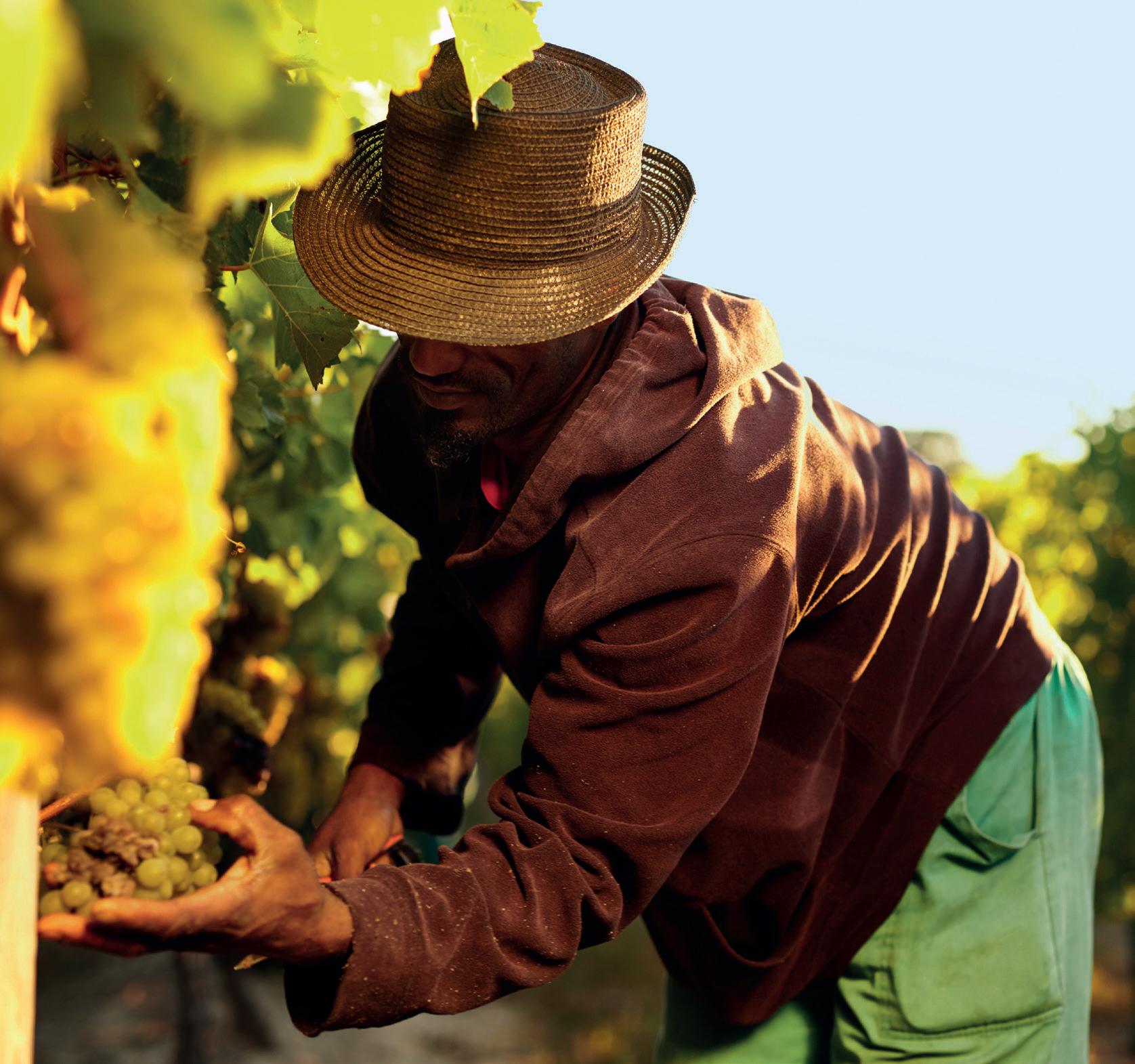
After a number of delays, and a set of last-minute changes that have frustrated environmental groups, the European Commission has reportedly reached an agreement with members on the Corporate Sustainability Due Diligence Directive (CSDDD).
The directive, initially agreed in December before a further round of lobbying, puts forward a legislative framework obliging companies to demonstrate the action they are taking to protect the environment and human rights.
It establishes a corporate due diligence duty to identify, bring to an end, prevent, mitigate and account for negative human rights and environmental impacts in a company’s own operations, subsidiaries and value chains.

In addition, some large companies are required to have a plan to ensure that their business strategy is compatible with the Paris Agreement to limit global warming to 1.5°C, while directors are incentivised to contribute to sustainability and climate change mitigation goals.
“[The law will help stop] businesses from looking away from very real human misery and destruction”
The directive also introduces duties for directors, including setting up and overseeing the implementation of due diligence processes and integrating due diligence into corporate strategy, taking into account the human rights, climate
change and environmental consequences of their decisions.
Nico Broersen, managing director at global compliance platform AgriPlace, commented on LinkedIn: “This marks a large milestone in the journey towards better labour rights and elevating environmental standards in global supply chains. The CSDDD reflects values that we are passionate about at Agriplace - it’s all about making a real difference in the way businesses operate and enabling it to be a force for good.”
Lara Wolters, a Dutch MEP with the Progressive Alliance of Socialists and Democrats (S&D), who led negotiations at the European parliament, said the law would help “stop businesses from looking away from very real human misery and destruction”.
However, she criticised member states that “persistently delayed” the adoption of the agreement. And
environmental campaigners hit out at late changes to the directive’s scope. The new agreement would apply to companies with over 1,000 employees, up from 500, as well as a net turnover of €450m, triple the amount earlier agreed.
According to estimates from environmental groups, the changes would exclude 70 per cent of the companies the law was meant to cover.
Anaïs Berthier, head of the Brussels office of Client Earth, an environmental law campaign group, told the Guardian that an opportunity to revolutionise how business is conducted in the EU had been “butchered” by corporate pressure and politics. E
PICTURED—The directive puts forward a legislative framework obliging firms to demonstrate actions to protect the environment and human rights

The UK’s Fresh Produce Consortium has warned that new fixed charges on imports of plants and fresh produce will not be manageable for many businesses.
by Fred Searle @fredfruitnetThe Fresh Produce Consortium (FPC) has hit out at the UK government for introducing new charges on imports that “threaten to cripple” SMEs in the fresh produce and plant sectors. The common user charge (CUC) is set to add millions in extra costs to the industry, while unnecessarily driving up fruit and vegetable prices, the industry body warned.

The CUC is being introduced as part of post-Brexit border controls, and applies to imports from all countries. The FPC predicts it will add £200m in costs across the fresh produce supply chain. The organisation described the move as “a crippling blow to a sector already grappling with unprecedented challenges”.
“This is simply not a manageable cost for our members,” said FPC CEO Nigel Jenney. “These exorbitant charges imposed by our own government represent a direct tax on businesses. It’s a move that will undoubtedly sha er supply chain confidence and is already encouraging EU exporters to reconsider their commitment to supply the UK market.”
The government has a empted to downplay the impact, arguing that consumers will see a negligible increase in prices. But according to the FPC, importers and retailers warn of “cascading delays, disruptions, and spiralling costs that will inevitably be passed on to hard-pressed shoppers”.
“The CUC system is particularly devastating for SMEs,” Jenney said. “While fees are now capped, they remain substantial – £145 for every consignment arriving in the UK via the Port of Dover or Eurotunnel. This might not seem like much, but with only a small number of consignments actually inspected, the [actual] cost per inspection balloons to a ludicrous £5k.”
The FPC instead wants to see “industry-managed solutions”, which it argues would offer a more efficient service. But the adoption and development of assured operator status, allowing responsible companies to manage their own inspections, has yet to begin.
Jenney concluded: “Ultimately, it’s essential the UK remains a destination of choice for international exporters to complement our fantastic homegrown fresh produce and to offer the choice and availability we all demand. The government’s poorly considered border solution puts this in severe jeopardy or, at best, drives avoidable food inflation.
“These insane charges are an a ack on those working tirelessly to feed and flower our great nation. The government seems hell-bent on punishing businesses that are the backbone of our economy and our health.” E
TOP— The CUC applies to imports from all countries ABOVE—FPC chief executive Nigel Jenney
The Spanish cooperative revealed its annual results for 2022/23 at its general assembly in Murcia.
by Carl Collen @carlfruitnetAnecoop has announced an increase in turnover of 2.7 per cent for the 2022/23 financial year, despite a drop in sales volumes.
At its general assembly in Murcia, the cooperative said that it had hit a record turnover of €846.9m, with the combined turnover of all Anecoop Group companies exceeding €1bn for the first time. Sales decreased by 14.3 per cent year-on-year to 650,978 tonnes, with lower production across almost all products as a consequence of adverse weather conditions.
Anecoop also highlighted the complicated economic and geopolitical situation that the business had endured.
“Although it is true that the situation is unfavourable for all sectors, ours is especially sensitive for many reasons,” said president Alejandro Monzón. “The most obvious, due to the immediacy of marketing that our products require and the almost daily adjustment of production costs.
“Aware of this reality, we have focused, as always, on mitigating the short-term consequences of the numerous open fronts that impact our sector, without removing focus from the strategies that we know are necessary to progress in the medium and long term.”

The 2022/23 period had seen an increased focus on innovation and R&D in the areas of biological pest control, the integration of artificial intelligence to improve production, and the modernisation of irrigation based on digitalisation and new technologies, Monzón outlined.
Joan Mir, director general of Anecoop, revealed that the growth of the average price per kilo paid to Anecoop’s partner farmers had risen 20.7 per cent over the previous year. He also agreed with Monzón on the importance of innovation as a lever for growth in the sector.
“The change we are witnessing is constant and has accelerated in recent years; We can only respond with innovation, with new management systems and greater efficiency,” Mir noted.

In terms of ongoing challenges, adverse weather, inflation and the increase in raw material costs, energy and the general cost of living, and “unfair competition due to the emergence of products from third countries” were all mentioned by Mir. E
One of Germany’s leading tropical fresh produce importers has created a new Latin American division and opened a brand new facility.
by Mike Knowles @mikefruitnetAt the start of 2024, Hamburg-based Afrikanische Frucht-Compagnie (AFC) created a new subsidiary called Südamerikanische Frucht-Compagnie (SFC) to focus on logistics, packing, and ripening services for tropical fruit. And in April, that business opened a brand new ripening and logistics centre at the city’s wholesale hub Großmarkt Hamburg.
The aim of the new venture, according to SFC itself, is to set “new standards” in service provision for tropical fresh produce including bananas. With a small team of just 15 staff, it has set out to be highly efficient, innovative, and – as a result – ultra-competitive.
The facility itself has a total of 22 controlledatmosphere ripening rooms that can accommodate approximately 30,000 boxes of bananas or other products per week.
The building itself, which is well located for onward distribution in the north of Germany, has a combined storage area of roughly 5,500m2 and cooling capacity for 900 pallets.
“We want to offer our customers flexible, serviceoriented and uncomplicated solutions,” explains SFC’s co-managing director Stefan Heine. “The focus is, for example, interim storage, order picking, cross docking, and ripening services. Our 24/7 availability rounds off the service.”
Florian Eßer, also managing director, believes the team offers a high level of expertise in the handling and distribution of tropical fresh produce. “We are proud to be able to make even better use of our many years of experience and expertise with the new centre,” he comments. “This also ensures the maturation and distribution of our traditional Onkel Tuca brand for our customers in the long term.”
The foundation of SFC represents a major new direction for AFC, which has traditionally focused on procurement in Africa and has been importing tropical fruit into Europe for more than a century. “By founding SFC, we are expanding and optimising the offering for our customers along the supply chain,” Heine adds. E


“We want to offer our customers flexible, uncomplicated solutions such as storage, picking, cross docking and ripening”
When it comes to assessing the carbon footprint of your business, it’s time to face up to net zero’s biggest challenge, says Ben Jones of Aethr Associates.
 IBEN JONES Aethr Associates Co-founder
IBEN JONES Aethr Associates Co-founder
n recent years, much of the focus has been on companies’ Scope 1 and Scope 2 emissions, which means their own direct emissions and the indirect emissions that result from the energy they buy.
But the carbon footprint of most businesses extends beyond the organisation itself. Typically, between 70 and 90 per cent of total emissions are created through supply chains, not internally. This is unsustainable. So, as
governments and business commit to net zero deadlines, attention has expanded to include tackling external, supply chain-related Scope 3 emissions.
This is a big challenge. Big food and big retail have already started to recognise the significant role that suppliers play in their carbon footprint story. But Scope 3 emissions are complex, and calculation methods relatively immature.
How, therefore, do you reverse an agricultural and supply chain

BELOW—Companies must look further back along their supply chains if they are to turn down the dial on emissions
revolution built on fossil fuels? It’s not easy, because right now there are some frailities in terms of measurement and mitigation. For example…
Scope 3 emissions arise from a broad range of activities across the value chain and involve a multitude of stakeholders.
Obtaining emission data from suppliers, particularly smaller entities with inadequate data processes, is an arduous process.
With numerous standards and methodologies, a clear understanding of Scope 3 emissions is challenging and comparisons inevitably misleading.
Encouraging suppliers to reduce emissions proves challenging due to varying levels of commitment and resources.
Reporting and compliance requirements vary significantly by region and industry for businesses operating in multiple jurisdictions.
Understanding how consumer behaviour might be affected by efforts to reduce carbon footprints is crucial. Will retail buyers choose local alternatives over imports due to their emission profile?
At Aethr Associates, we recognise that measuring a carbon footprint, including Scope 3, is just the beginning. With stakeholders increasingly mandating the calculation of total carbon footprints, and the implementation of net zero action plans, annual carbon footprinting will become the norm.
To translate that into action, you need to engage positively with suppliers. But this takes time and resource. Other priorities, like water shortages or plastic reduction, could take precedence.
Regardless of where you are on your sustainability journey, there’s no time to waste. In the coming years, navigating the path to net zero will undoubtedly challenge even the most resilient businesses. E

The first winners will be announced at September’s GlobalGAP Summit.
by Maura Maxwell @maurafruitnetFoodPLUS, the company behind GlobalGAP and the GGN label, is to launch a brand new awards scheme celebrating those fostering positive change in the world of farming.
The first annual Changemaker Awards will be announced at the GlobalGAP Summit 2024, which takes place 10-12 September in Warsaw.
The awards recognise commitment to promoting responsible farming practices and fostering positive social change, focusing on cross-industry initiatives that foster responsible change in the industry.
Those wishing to enter in three categories – producers, retailers and certification bodies – can apply between 10 April to 10 May.
To enter, they must demonstrate three things: exemplifying responsible agricultural cultivation methods and implementing innovative approaches to resource
efficiency; promoting socio-economic development and the well-being of local actors along global supply chains who are commi ed to the United Nation’s Sustainable Development Goals; and contributing to the transfer of knowledge and education as well as supporting inclusivity and diversity in local communities.
The international jury, consisting of the organisation’s senior management and advisory board, will shortlist nine candidates from the applications whose innovative practices and forward-thinking concepts make a significant contribution to the common good.
These nine candidates will be presented at the GlobalGAP Summit in September, where the final three award winners (one from each of the three categories) will be selected by democratic vote of a endees. The winners will receive their Changemaker 2024 award during the evening event on 10 September. Applications will be accepted via an online form on the Summit 2024 website. Participation and application for the Changemaker Awards is free of charge. The invitation to the Summit in Warsaw is also free of charge for the nine shortlisted candidates. In order to encourage and inspire creativity in the application process, FoodPLUS said there are no requirements or predefined criteria for applying. E
LEFT—Prizes will be awarded in three categories; producers, retailers and certification bodies
The Global Coalition of Fresh Produce, the body bringing together fresh produce associations from around the world, has launched its second global survey into the costs of fruit and vegetable production and trading, and the prices received by growers and intermediaries.
The survey is a follow-up of the one it conducted in March 2023, when producers and traders the world over were facing unprecedented cost hikes.
The coalition is repeating its survey to understand how the situation has evolved over the past year. It said the new data will support the development of global and national perspectives on the evolving impacts of production and trading costs in the following regions: Canada, the US, Europe, Africa, New Zealand, Australia and South America.
“We are conducting this global survey to shed light on the challenges experienced by actors in the fresh produce supply chain worldwide,” said Ron Lemaire, chairman of the coalition. “The results of this new survey will help the industry, its partners and all government levels to understand the current impacts of production and operating costs and selling prices and work together to address them.”
All industry actors are invited to complete the short survey to support the coalition’s efforts to frame and understand the challenges the industry is experiencing today. To participate in the survey, go to www.surveymonkey. com/r/MKBGJKQ.














With the virus at the forefront of the industry’s thoughts, we speak to those fighting back


The sweeping response to the threat of tomato brown rugose fruit virus from those responsible for developing new varieties is admirable and encouraging
ou will not be surprised to see that much of the focus of this year’s Fresh Focus Tomato special is fixed firmly on the battle against tomato brown rugose fruit virus, or ToBRFV. Since its emergence and spread in the past decade, the virus has been identified as the single biggest challenge that faces the category today. However, the reaction of the industry has been swift and determined – if evidence is needed, take a glance at the next few pages – with breeders working hard to develop varieties that offer resistance to the threat. Seed companies are featured heavily in this special, and with good reason. They are the ones on the front line, researching and ultimately introducing those characteristics that stand strong against ToBRFV. The range of resistant products that have already been launched is both admirable and encouraging. And let us not forget, this is in addition to the plethora of other traits that must be considered when producing a new cultivar, be it yield, climate resilience, shelf-life, colour, and of course flavour. There is much to be positive about when it comes to tomatoes, one of the healthiest, tastiest and most versatile fresh product segments out there. And with so many taking on ToBRFV head on, that positivity will hopefully remain for some time.
Carl Collen, EditorRuud Kaagman, Syngenta Vegetable Seeds global crop unit head tomato, tells Fresh Focus Tomato that the category continues to innovate, evolve and grow despite the challenges presented by ToBRFV.
by Carl Collen@carlfruitnet

Where is Syngenta’s current focus when it comes to developing the tomato category?
Ruud Kaagman: Syngenta has been actively breeding in all major tomato segments and growing
methods. From high-technology greenhouses to open field production, growers need solutions wherever they are and for any of the unique challenges and diseases they face. Some of this research includes future-ready production, ready for mechanical harvesting and AI. We’re continually sharing these insights with our growers
to help them prepare for future challenges and opportunities.
Obviously a lot of the talk right now is about ToBRFV resistance. What have you been doing in this area?
RK: Tomato Brown Rugose Fruit Virus (ToBRFV) represents the biggest threat to tomato
By the end of 2023
OPPOSITE LEFT— Ruud Kaagman
OPPOSITE RIGHT—
The company’s Maturbo variety


more modes of action to protect this important crop.
“We know ToBRFV is top-of-mind for growers, and we’ve been dedicated to finding solutions since its discovery”
productivity today: it diminishes yields up to 100 per cent, damages fruit quality, and is incredibly expensive to remove from greenhouses. We know this is topof-mind for growers around the world, and we’ve been dedicated to finding solutions since it was discovered in 2015.
We introduced our first resistant varieties in 2020, beefsteak tomatoes, but we haven’t slowed down since. By the end of 2023 we had 15 tomato varieties on the market with ToBRFV resistance, including beef, cluster, and baby plum/snacking tomatoes.
In 2024, we will launch many more resistant varieties. We’re actively trialling four new rootstock varieties for commercialisation this year, where growers will have access to ToBRFV-resistant rootstock and ToBRFV-resistant scion. In addition to resistance on the market today, we’ll continue to integrate ToBRFV resistance into all kinds of tomatoes and growing styles and continue researching
What are the other key traits when it comes to tomato development?
RK: When you look at the different segments, there are obvious trends in what growers need. In hightechnology greenhouse production, we’re expanding our portfolio by adding more cherry on-thevine and cocktail types. For these tomatoes, retailers need year-round supply, which is why we accelerate trait development for both heated and unheated greenhouses, to help enable supply stability for retailers and consumers.
In open field environments, we are supporting growers with varieties that can stand against the increasing pressure of stress and disease, especially our programmes for Asia and Africa/Middle East. At the same time, we’re creating the best shelf-life for our varieties as they need to survive long distance travelling from growers to consumers in these regions.
When it comes to agronomic concerns, ToBRFV resistance is often top-of-mind, but that’s not the only threat tomatoes face. We’re continually finding and combining resistances to diseases and threats that matter to growers. Additionally, taste is important to protect tomato space in the grocery store and appeal to consumers, so
we’re developing novel traits to improve taste.
Are there any new varieties that are exciting you?
RK: We’re thrilled with the planned 2024 launch of resistant rootstock to be paired with resistant scion, giving growers improved options in greenhouse grafting. We also introduced ToBRFV-resistant Climundo, an on-the-vine variety, in addition to several snacking and baby plum varieties with resistance to ToBRFV as well as with excellent taste and shelf-life. When it comes to taste and consumer preferences, we’re launching a new golden cherry tomato called SunFun. It was recently awarded by the International Taste institute in Belgium and it is launching this year in the US.
Is the tomato market still a strong one globally?
RK: The tomato still one of the most eaten vegetables around the world, and we do not see this changing. In fact, there is still a growing demand for small types as more countries adopt these types as a healthy snack. There is also an ongoing trend in increasing the acreage of greenhouse tomatoes, especially as it allows growers to produce closer to urban areas and significantly improve yield, consistency in quality, and strongly improve the ecological footprint due to less pesticide use and less water usage. We see these developments in Asian countries, Central Asia, Dubai, and Saudi Arabia. Across the globe, the demand for tomatoes will continue to grow due to new innovations for consumers.
Do you think enough is done to market the benefits of tomatoes to consumers?
RK: We’ve seen great strides in consumer marketing in recent years. For example, baby plum ‘snacking’ tomatoes. These small, bite-sized tomatoes

provide excellent health benefits, convenience, and ‘fun’ for consumers around the world. That market space is continuing to grow, and consumers are asking for more options, because it fills a need they have. This is a great example of how innovation, together with retailer support and marketing, has created new opportunities for growers and a great product for consumers.
As always, there are more opportunities to reach consumers. We’re seeing great innovations like the purple Yoom tomato with more anthocyanins for an overall greater health profile. As it and other innovations enter the market with features that clearly target consumers, we’ll want to make sure we’re working closely with retailers, restaurants, and consumers to explain the benefits of these new innovations, and how they can easily fit into lifestyles to provide healthy alternatives.
How else do you see the tomato industry evolving?
RK: At Syngenta, we’re passionate about innovation and continuous improvement, and one thing many people don’t realise about tomato production is that it’s incredibly high tech. It’s exciting
to think about the steps we’ve taken to improve our research and development to get new products to growers and consumers, faster. For example, we’re using a robotic tomato harvester in our greenhouses. This machine is capturing data as it harvests tomatoes, removing any potential human error and capturing incredible amounts of data in a short time. In addition, as robotic harvesting becomes more popular for growers around the world, it will be important for us to understand preferred plant structures that help support robotic harvesting. The trial we’re

completing with robotic harvesting is helping us learn how to breed and adjust plant structures, and ‘teaching’ the robot more about how to differentiate ripe tomatoes from the rest of the plant.
Robotics aren’t the only innovation we’re experimenting with. AI and many advancements in data analytics are helping us push breeding advancements to growers, faster, too. Altogether, technology is opening doors through faster data collection and organisation, and we’re able to take what we know inherently about genetics, combined with this data to discover next-generation tomatoes.
ABOVE —Syngenta’s ToBRFV-resistant range includes cluster, baby plum, beefsteak and many more tomato options BELOW—There is also an “ongoing trend” in increasing the acreage of greenhouse tomatoes, Kaagman says

The roadmap to ToBRFV-resistant tomatoes.
Tomato viruses are evolving, which means our research is ongoing. We will continue to expand our portfolio of resistant varieties, find new and better solutions to ToBRFV and whatever comes next...



We will not compromise on taste, shelf life and other important characteristics that growers need to harvest plentiful crops keeping grocery stores and plates full of healthy tomatoes – of every shape and size!

The greenhouse, located in Kwintsheu near The Hague, features over 150 ToBRFV-resistant varieties.
by Carl Collen @carlfruitnetBASF-Nunhems has officially opened its Tomato Experience Center in Kwintsheul, near The Hague in the Netherlands. According to the seed specialist, the greenhouse features over 150 ToBRFV-resistant varieties.
The greenhouse is complemented by meeting facilities to showcase these varieties and exchange with customers on their needs, BASF’s innovations and trends in tomato breeding, it said.
“Customers and growers from around the world can explore the greenhouse and displays filled with different tomato varieties, offering opportunities to taste, touch, smell and slice the diverse range first-
hand,” BASF-Nunhems stated.
A comprehensive data collection on cultivation facts, production statistics, shelf-life, weight and more are also on display at the centre to provide customers with valuable insights for informed decision making.
Silvia Cifre, vice-president marketing and sales at BASFNunhems, said that tomato breeding held an “immense” significance given the importance of the segment globally.
“From the moment ToBRFV erupted, BASF-Nunhems has been at the forefront in finding solutions to win the ba le against this virus,” Cifre commented. “Until now more than 25 ToBRFV-resistant varieties
ABOVE—Vitalion, one of BASFNunhems’ ToBRFV-resistant varieties
Hazera has announced the acquisition of a new high-tech greenhouse next to its headquarters in Made, the Netherlands. According to Yossi Shapiro, head of R&D, the acquisition marked a “significant step” in Hazera’s journey to establish a strong position in the high-tech greenhouse tomato industry.
“Our goal is to establish ourselves as one of the leaders in the high-tech tomato market with our mid- to long-term plan, as there is strong competition there,” he said. “This goal was the primary motivation to invest in a state-of-the-art active tomato greenhouse, as you need the best facilities to compete with the best.”
The group said that it was empowering its tomato portfolio worldwide through the new high-tech tomato project with the support of Limagrain’s vegetable seed division.
Shapiro noted that multiple options were considered, such as renovating existing facilities or building a greenhouse from scratch.
“But the answer was right in our own backyard: to buy an industrygrade, commercial greenhouse operation that we can readily transform into a research facility with the help of our experts,” he said.
are providing solutions to tomato growers worldwide.
“We are proud to open the doors today of our Tomato Experience Center,” she noted. “BASF has been in the tomato seed business for over 50 years and with this innovative facility we can show how much our portfolio and cultivation technology have evolved. In this inspiring environment, we will be able to take our collaborations with all players along the value chain to the next level.”

Win the battle against rugose, don’t compromise on quality
Sometimes you can have it all


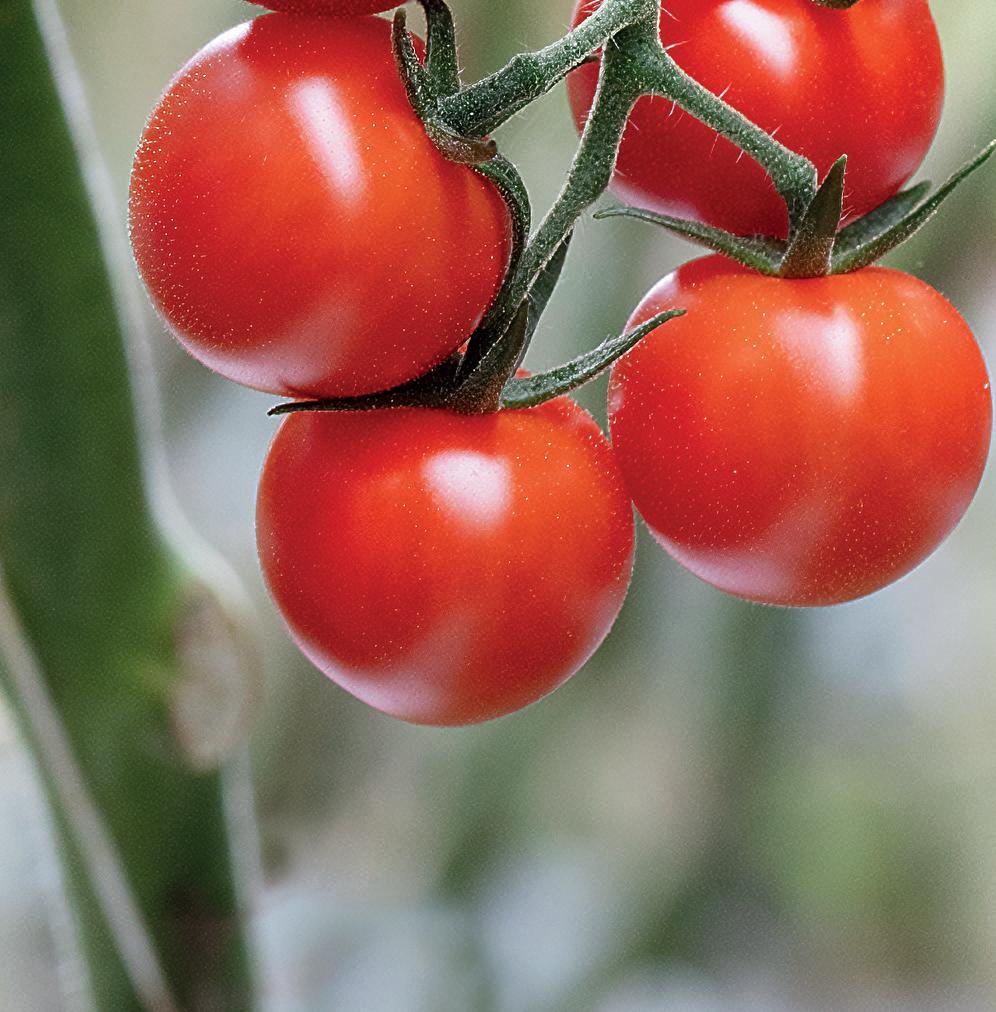

BASF | Nunhems stands out with versatile solutions for all different segments and the multitude of challenges that growers face. The BASF | Nunhems portfolio is highly regarded when it comes to ToBRFV-resistant tomato varieties. They all meet the requirements of the different levels of the agri-food value chain. Despite their good marks in vitality, productivity, and plant health, Nunhems® Rugose resistant varieties do not compromise on crucial consumer aspects such as flavor, color or visual appearance.
All in all, we offer over 200 tomato varieties, including top sellers:
• Vitalion, Ronvine for High-tech production
• Azovian, Blindon, Freezon, Brovian in the saladette segment
• Cabosur for cluster
• Mohikan for single winter for Mid tech production
Discover our Tomato Experience Center in Kwintsheul, the Netherlands
The BASF | Nunhems Tomato Exerience Center offers a unique platform for customers to explore, test, and showcase these innovative varieties grown in high-tech conditions. Curious to see the impact of our solutions firsthand? Join us at the Tomato Experience Center and be inspired by our passion for innovation and top-notch quality in the tomato business.
Get in touch with us
Contact our experts if you are interested in learning more about our offerings.
Ester Serrano Banuls
Regional Crop Lead EMEA ester.serrano@basf.com
Harm Ammerlaan
Regional Crop Lead Hightech harm.ammerlaan@basf.com
Jose de Jesus Morales
Regional Crop Lead Americas jose.de-jesus.morales@basf.com
Or visit our global website www.winthebattleagainstrugose.com and select your country page.
Resistance is important as the fight against ToBRFV continues, but other traits such as taste, shelf-life, colour and yield are also crucial given retail and consumer preferences.
by Carl Collen @carlfruitnet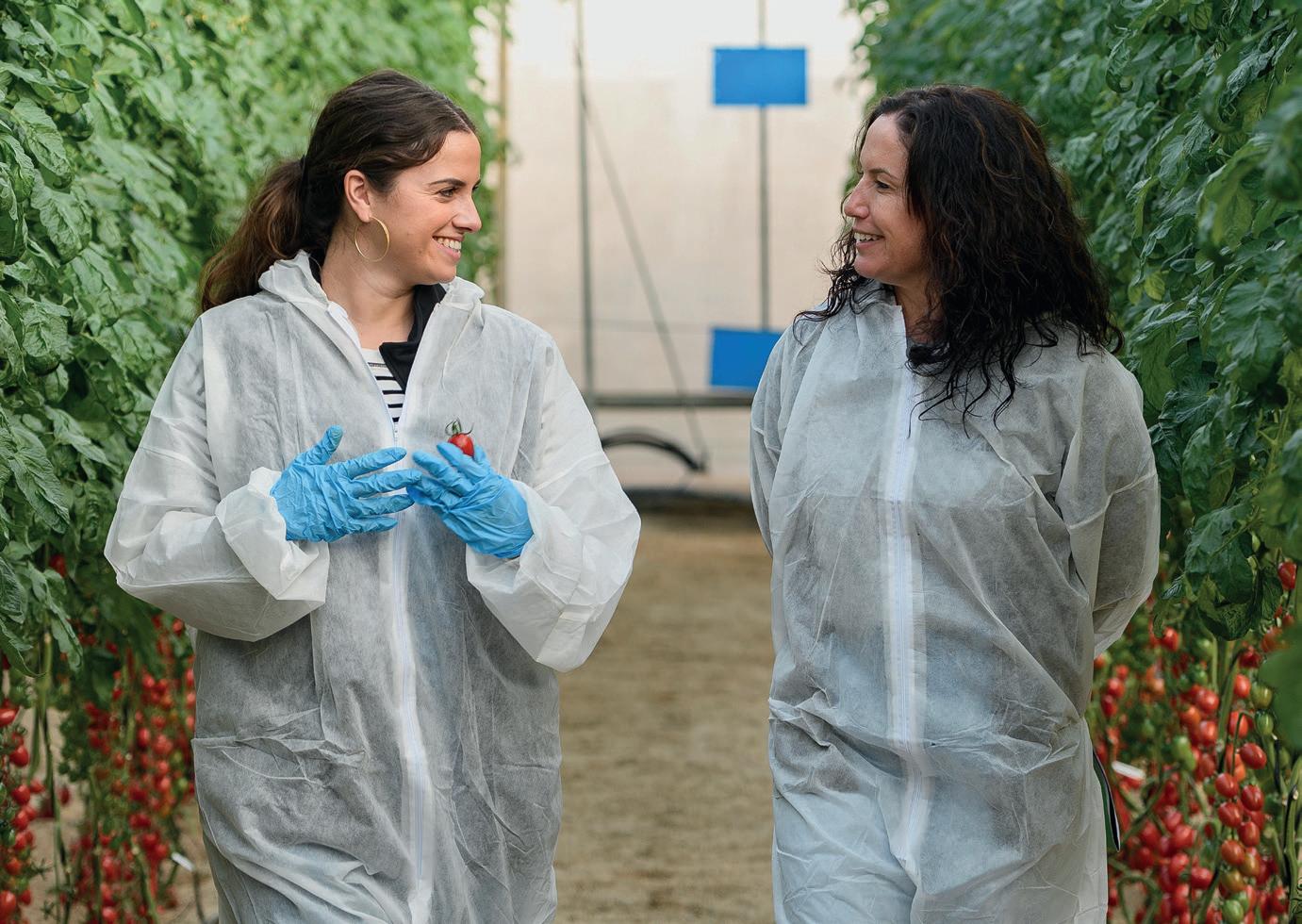
Two major themes stand out when it comes to the tomato category, according to seed specialist Enza Zaden. These are the emergence of Tomato Brown Rugose Fruit Virus (ToBRFV) and its impact on the sector, and the way retail trends are reshaping the category. The former has brought about significant challenges, testing the adaptability and resilience of the tomato industry worldwide.
Mari Carmen Manjon, sales manager Iberia at Enza Zaden, says that the virus represents a considerable threat to all agents in the chain, from production to postharvest quality. “At Enza Zaden, we’ve led the innovation charge with the development of High Resistance (HREZ) varieties and rootstock, providing an effective solution to combat this threat,” she explains.
Enza Zaden’s growers have been instrumental in the fight against ToBRFV, Manjon notes, implementing enhanced phytosanitary measures and adjusting cultivation practices, such as modifying planting dates and shortening harvest cycles, to safeguard their crops. Despite these concerted efforts, the ba le against widespread infections of ToBRFV remains “formidable”, which underscores the need for a united and robust response from the entire industry, with the group taking a collaborative approach.
“In parallel, our commitment extends beyond disease resistance to embracing sustainability,

including the development of varieties more resilient to abiotic stress and suitable for organic cultivation,” she tells Fresh Focus Tomato. “These innovations align with our mission to support the industry’s adaptation to environmental challenges and shi ing consumer preferences for sustainable products.”
Manjon explains that Enza Zaden was a pioneer in the field of ToBRFV, being the first to bring HREZ varieties to the market, addressing the virus with “a unique hypersensitivity reaction”. This mechanism prevents the virus from multiplying within the plant and blocks ToBRFV’s spread under normal virus conditions, taking a significant step towards long-term eradication.
“Our rapid development and offering of a comprehensive programme and an extensive assortment of varieties with High Resistance have addressed the sector’s urgent needs in record time,” she continues. “This approach not only mitigates the immediate threat posed by ToBRFV but also underscores our commitment to the tomato industry’s sustainability and the health of the food supply chain.
“It’s important to note that HREZ does not equate to immunity. We continue to encourage growers to implement robust phytosanitary measures alongside adopting HREZ varieties and rootstocks to limit the virus’s spread effectively. Our introduction of HREZ
»




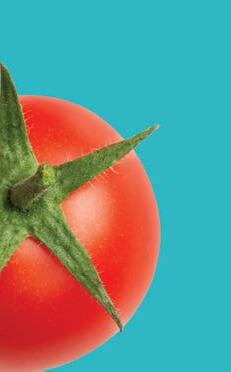







































rootstock represents the next level of innovation, adding a critical defence layer by blocking ToBRFV at the root level and contributing to the plant’s overall resistance.”
The HREZ collection includes varieties across all significant tomato types, from large roma, beef, grape, cherry and cocktail to on-the-vine tomatoes, demonstrating Enza Zaden’s ambition to bring the innovation to all tomato growers.
When it comes to those aforementioned retail trends, it is evident that supermarkets are increasingly organising shelves by function rather than product category, which means distinguishing snack tomatoes from those intended for cooking. Manjon points out that packaging now often includes clear information about the best use of each tomato variety – be it for cooking, grilling, snacking, or salads. This trend towards functionality over category helps guide consumer choices and highlights the diverse applications of tomatoes in daily diets.
Beyond resistance, critical traits

versatile breeding strategy that not only caters to the broad spectrum of consumer preferences but also ensures that traders and retailers can offer the best quality across their main tomato assortment.”
“Consumers’ desire for variety is strong. Preferences vary from higher-taste segments to more economical options”
in tomatoes include taste, shelflife, colour and yield. These meet the growers’ need for healthy, productive plants, and align with traders and retailers’ challenges of ensuring year-round availability and quality in their main assortment, such as salad, truss, and plum tomatoes. Indeed, the last two years have underscored the necessity of consistent supply, she notes, with the unprecedented sight of empty shelves highlighting the importance of resilience in production and distribution.
“Consumers’ desire for variety remains strong, with preferences varying from higher-taste segments for special occasions to more economical options that provide the foundation for a healthy meal,” Manjon comments. “This diversity in consumer choice highlights the necessity for a
Enza Zaden is adopting a proactive approach to customer management through the development of a new tomato programme, she confirms, which is focused on introducing new, tasty, and highquality varieties that cater to the evolving needs and preferences of customers.
“It’s this commitment to listening and responding with useful, quality products that truly sets us apart,” says Manjon. “By addressing the demands of the market with solutions that meet their expectations, we further solidify our position as leaders in the tomato industry, committed to innovation, quality, and customer satisfaction.”
The tomato business is seeing stable demand in key markets like the Benelux, with consistent consumer interest driven by the crop’s versatility and nutritional value. The industry’s ability to innovate and adapt, particularly through the introduction of HREZ varieties, supports this steady demand, she explains. However, there is room for growth in espousing the benefits of the product to shoppers.
“While the intrinsic health benefits of tomatoes are recognised, there could be room to enhance consumer engagement through branding tomato varieties,” Manjon adds. “Greater emphasis on marketing the unique qualities of different tomato varieties, including taste profiles and health benefits, could enhance consumer engagement and appreciation.”
TOP LEFT—Key traits include taste, shelf-life, colour and yield
TOP RIGHT—A range of HREZ varieties is available
The global solu�on to improve the performance of your tomato processing facili�es
· Versa�lity (sor�ng and grading a large variety of tomato types)
· Delicate fruit handling
· Easy maintenance (automa�c cleaning and lubrica�on)





rodasale@mafroda.es





Rijk Zwaan’s new congress Tomeet discusses the challenges and opportunities facing the sector.
by Maura Maxwell @Maura MaxwellLeading players in the Spanish tomato business met in Almería in April to discuss the current and future challenges facing the sector at Rijk Zwaan’s first-ever Tomeet Congress.
Once the dominant player in Europe’s winter tomato market, Spain has borne the brunt of an influx of cheaper Moroccan tomatoes in recent years that have gradually whittled away its market share. At the same time, the impact of climate change, rising production costs and an increasingly punitive European legislative environment have created a grim commercial landscape for tomato producers in the Iberian Peninsula.
Luis Fernández of Coexphal highlighted Spain’s loss of competitiveness against third country suppliers like Morocco where costs – particularly labour costs – are much lower. “This means that we have to work more efficiently, with the help of new technologies, and that we have to differentiate ourselves from our competitors,” he said.
David Uclés of Cajamar agreed that producers faced growing insecurity and uncertainty in the short-term, but painted a picture of a more positive future, in which lower interest rates will fuel more investments in technological improvements; the move to a plantbased diet will boost demand and imports from third countries
will be forced to comply with EU regulations.
The programme then moved on to the subject of sustainability.
Ana Hernández, director of R&D&i and Environment at Grupo Paloma, gave an overview of how the company is adapting its processes to become more sustainable and meet the challenges of climate change. These include opting for biological controls and hydroponic cultivation, optimising water usage and reducing CO2 emissions.
There then followed the first of two round table discussions featuring José María Naranjo, head of the Tomato Project at Carrefour Spain; Antonio Algarra Ibáñez of Grupo Agroponiente, and Pedro Ruiz García, president of Cooperativa La Palma. All
three producers agreed that adopting varieties with resistance to ToBRFV was a priority for the sector. The need for retailers and producers to work more closely together to address common challenges, such as educating consumers about the different strands of sustainability was also highlighted.
Maria José González of consumer research firm NiQ presented the results of a survey showing that German consumers prioritise appearance, taste and price when buying tomatoes, although they highly value proximity and local products.
Continuing with the opportunities and challenges of the future of tomato exports, Wouter de Ruiter of De Ruiter Interim & Consultancy, talked about the very different strategies of European retail chains and the need for suppliers to tailor their offer and service to each one.
The challenges that the sector must face to differentiate itself and lead winter supply were analysed in a second round table featuring Juan Jesús Lara of Casi; Mais Zakarne of SanLucar and Enrique de los Ríos of Unica Group. The relative merits of different marketing strategies were discussed – from SanLucar’s success in positioning its brand with European retailers to the creation of an Almerían of Spanish tomato brand.
All the speakers agreed that it was necessary to invest more in promotion and once again called for greater unity between the entire sector to be stronger in the market.
At the end of the congress, Rijk Zwaan presented some of the solutions it has developed to respond to the new challenges facing the sector, notably ToBRFV.




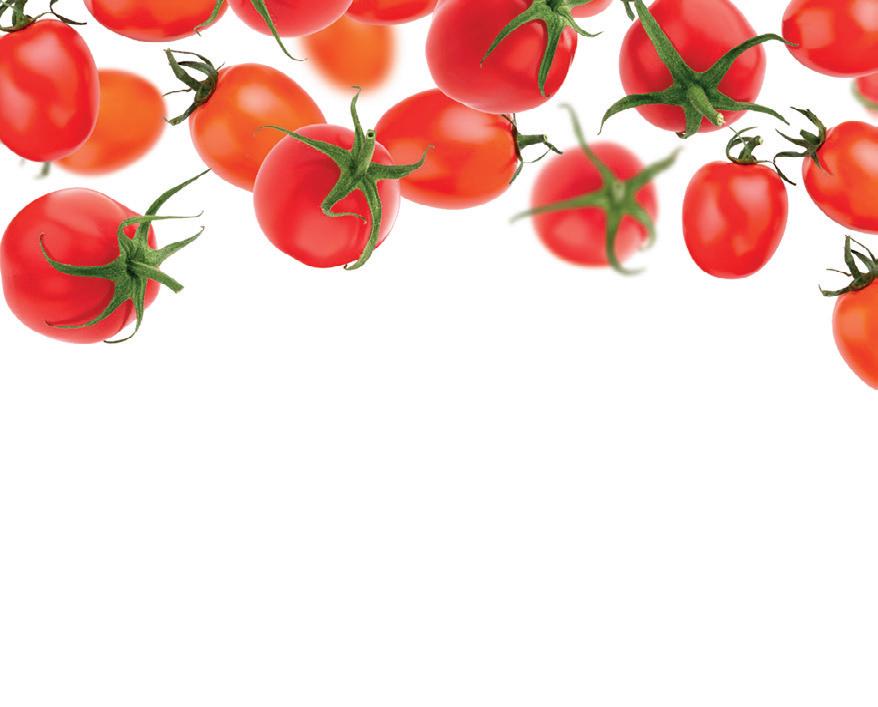





series


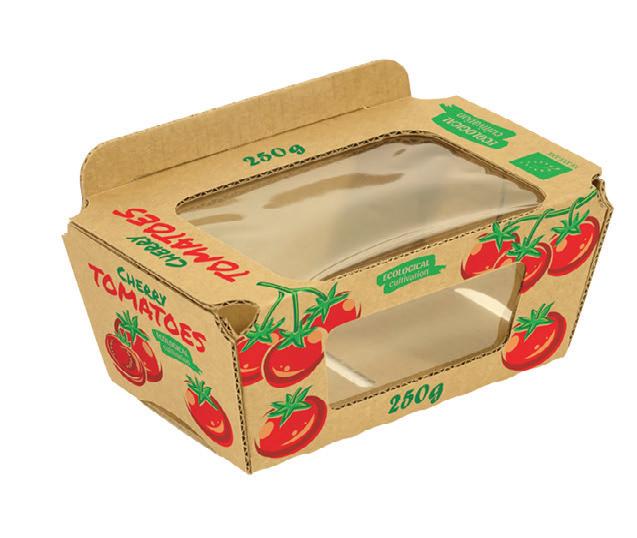






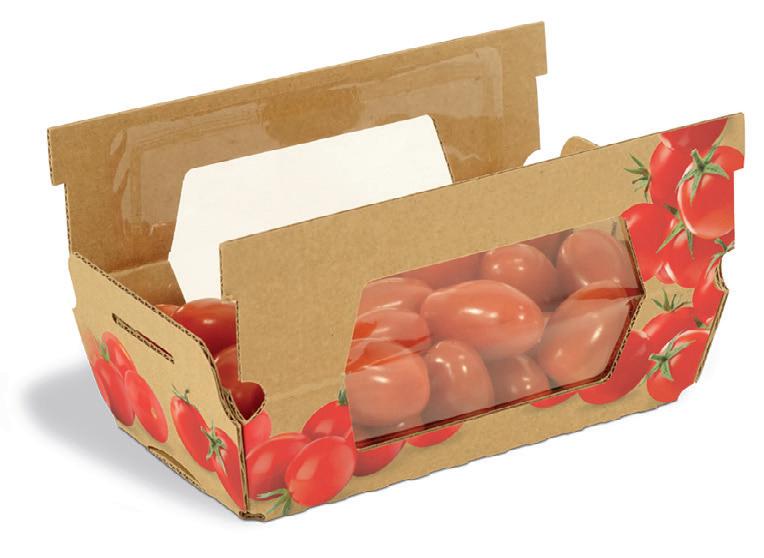






Bayer’s vegetable seed segment is launching its first wave of ToBRFV-resistant tomatoes this year, encompassing a range of types and varieties.
by Carl Collen@carlfruitnet
It has been a busy year at Bayer Crop Science’s vegetable seeds division. In the tomato segment it is running full steam ahead, launching ToBRFV-resistant tomato varieties, driving pipeline breeding processes, supporting growers and factoring in breeding and selection for sustainable production into its targets. This is all while responding to climate volatility and safeguarding scarce resources along the food value chain.
When it comes to ToBRFV, Bayer has taken the time to do things properly, according to Anne Williams, head of protected, vegetable seeds.
“Rather than rush in to bring low-grade single gene resistance or single gene high resistance with poor fruit quality, we’ve taken a little longer to build stronger and protect both growers’ livelihoods as well as consumer demand,” she outlines.
Bayer’s multi-gene resistance stacks are launching across a range of tomato types and varieties this year, bringing durable resistance to anticipate future adaptations by the ToBRFV virus. Tested across Bayer’s multi-environment, multiseason, multinational and multivirus inoculated and background infection long cycle crop trials series, Williams says growers can enjoy the confidence of producing these varieties.
At the same time, Bayer has been protecting fruit quality and taste to ensure that consumers continue to enjoy the taste they choose tomatoes for, with every ToBRFVresistant variety launched tastechecked through Bayer’s consumer R&D panels. And there are several exciting prospects on the horizon.
“This season sees the first wave of our ToBRFV-resistance variety launches, so we have a lot to choose from and we’ve many, many more to follow,” she reveals. “There is a very nice tasting cherry plum variety that looks good and tastes great, and the first large truss varieties are holding fruit size well –a characteristic that often suffered in some of the earlier competitor material. We also have some beautiful saladette varieties in the ground this year.”
Williams rightly points out that “growers don’t like surprises”, so breeding tomatoes with traits that make for consistent production is critical.
“Consistent performance in behaviour and output, adaptability to changes in management conditions and resilience to pest and disease attack across an increasing range of challenges –this is part of the reason we have a broad base trait stack included as standard across most of our breeding pipelines,” she explains.
“If we switch to our consumer


hat, we want attractive fruit with great taste, shelf-life to avoid food waste, and to know that every time we buy a tomato it tastes exactly as we expect it to taste,” Williams adds. “We buy with our eyes so it needs to look good, and whilst we’re prepared to pay more for premium products if we can afford them, everyone needs access to year-round, affordable good quality fresh produce.”
Group continues to showcase its commitment to leading in tomato breeding through innovation, offering a diverse range of products.
by Carl Collen@carlfruitnet
Sakata is ramping up its research and development efforts in the EMEA region, focusing on creating the best vegetable varieties. This is according to Stéphane Bucamp, senior product manager tomato at Sakata Vegetables EMEA.
The group is working across all key tomato segments, such as cherry, miniplum, salad, saladette and more, aiming to offer a diverse selection that meets a wide range of tastes and growing needs.
Bucamp says the work is driven by Sakata’s core philosophy, which is about understanding and addressing global challenges like environmental conservation and the need for healthy food.
“This philosophy pushes us to produce tomatoes that stand out for their taste, nutritional value, and how well they grow,” he tells Fresh Focus Tomato. “Our aim is to ensure that each variety of tomato we develop not only meets but exceeds the expectations of everyone involved, from growers to consumers. Sakata focuses on making sure tomatoes taste great, can grow in different environments, and are good for your health.”
This includes tackling ToBRFV, and Sakata is actively tackling this challenge by screening existing varieties for tolerance and developing new ones that can
yield, fruit quality, and disease resistance to other pathogens, with growers prioritising robustness and ease of cultivation while consumers demand taste, nutritional value, and appearance. “Our breeding programmes focus on meeting these diverse needs, ensuring our tomatoes satisfy all market segments effectively.”
On the consumer side, Bucamp feels that while efforts have been made to highlight the health benefits of tomatoes in recent years, there remains room for enhancing awareness about the nutritional

resist the virus.
“With the introduction of varieties like Chocostar F1, Luciestar F1 and Royalstar F1, which confirm consistent levels of tolerance to ToBRFV (intermediate resistance), we’ve made significant progress,” Bucamp continues.
“Moving forward, Sakata aims to enhance breeding programmes further, incorporating advanced research to bring varieties that not only resist ToBRFV but also meet the high standards for taste, yield, and environmental sustainability.”
The coming months will see Sakata announce new materials across different tomato segments that will have intermediate resistance to ToBRFV, marking a significant milestone, he confirms.
There are also many other traits that Sakata focuses on, including
advantages and the diverse range of tomato products available.
Educational campaigns and collaborative marketing initiatives could elevate the profile of tomatoes as a key component of a healthy diet, he says. One such initiative is Sakata’s La Pandi programme in Spain, a project designed to promote healthy eating among school children, which won Spain’s NAOS Award for its contributions to advancing public health. Such educational campaigns and collaborative marketing efforts play a crucial role in enhancing the perception of vegetables as essential to a nutritious diet.
“Our continuous investment in research and development, coupled with our proactive approach to addressing challenges like ToBRFV, underscores our commitment to excellence in the tomato category,” Bucamp concludes. “We aim to remain at the forefront of delivering innovative solutions that benefit the entire value chain, from growers to consumers.”
Fogliati believes its new Nama brand will drive sales of domestically grown beef tomatoes across Italy, and provide shoppers with a top-quality, local option.
by Mike Knowles@mikefruitnet
Turin-based company
Fogliati has supplied Italy’s supermarkets with local and imported tomatoes for many years, among a range of different products under its long-established Trifoglio brand.
But now it has unveiled a new brand, Nama, for what it describes as a highly promising cuore di bue variety grown exclusively in Italy.
And it says demand for this locally grown product, which it markets as ‘born mature, born Italian’, is only going to increase.
With an intense flavour and colour, as well as apparently excellent shelf-life, the product was initially grown in Sicily, Veneto and Piedmont. The production window is currently over nine months, but this is expected to extend to year-round supply shortly with the addition of new plantings in Calabria and Lazio.
Of course, to achieve commercial success with a new product in this category would be no small achievement in a country where tomatoes are already extremely popular and play such a central role in the national cuisine.
But Fogliati’s hope is that a highquality, Italian-grown beef tomato can a ract consumers who would otherwise purchase imported ones.
“The Nama project was created primarily on the back of our experience importing tomatoes,”

“The market for cuore di bue tomatoes in Italy is growing, and retailer interest in particular is strong”
explains company owner Eraldo Fogliati. “We understood the importance of developing an Italian supply chain that meets the needs of consumers and buyers in Italy. The market for cuore di bue is growing, and retailer interest in particular is strong.”
Stefano Landolfi, project manager at Fogliati, believes the skill and expertise shown by Nama’s growers gives the product a major commercial advantage.
“Nama’s product quality is guaranteed, not only by its specifications and technical data sheets, but also by the way the

product is managed in the field, which ensures compliance with the specifications,” he comments. “We are fortunate to have had a decades-long collaboration with a team of agronomists – led by Francesco Furnari –who take care of its production throughout Italy.”
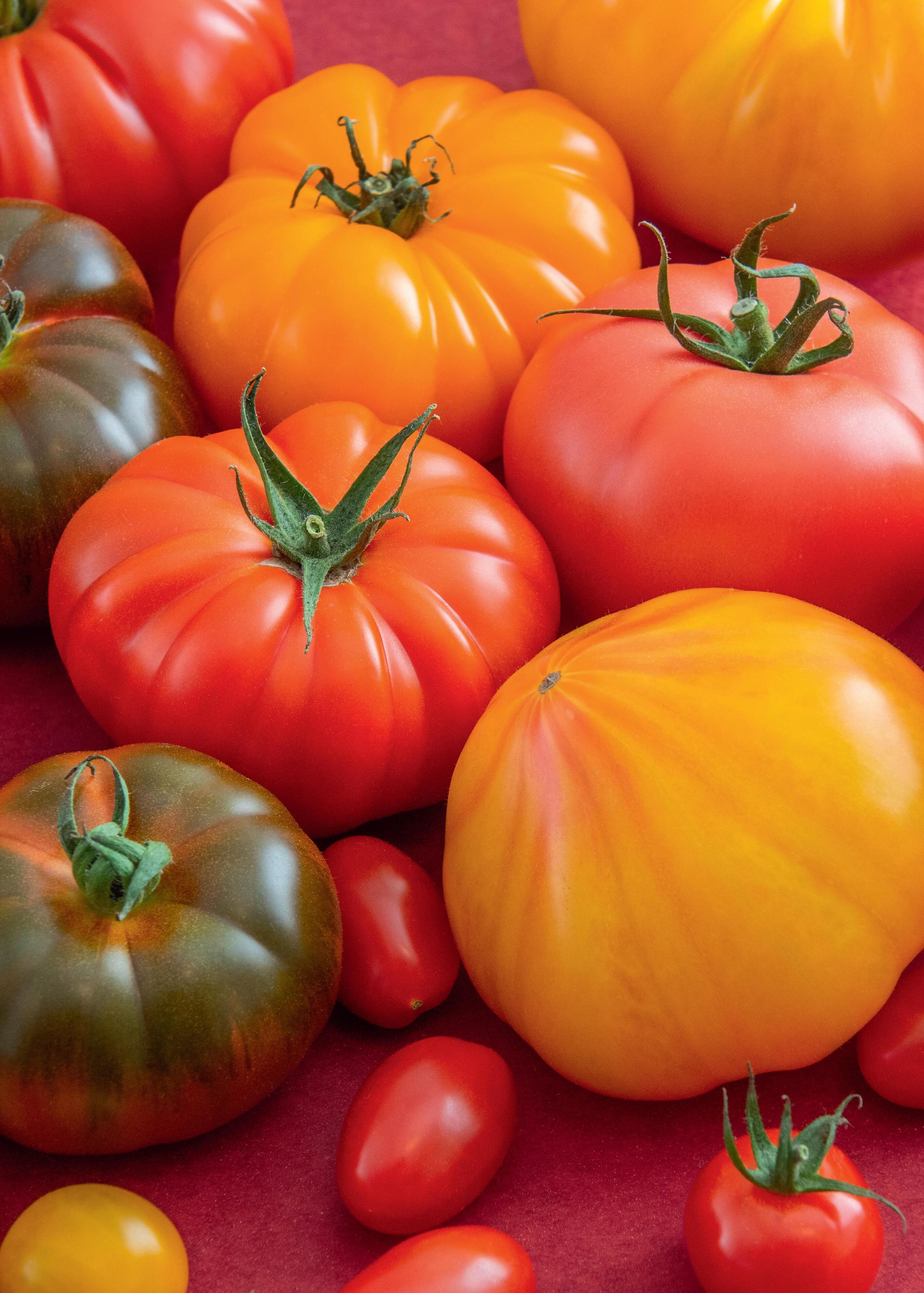
Cost pressures, supply chain disruption, and the threat of ToBRV are taking their toll on the British tomato sector, but Alex Margerison-Smith of Keelings sees opportunities for innovative growers with a focus on premium varieties.
by Fred SearleWhat are the main trends in the UK tomato sector currently?
Alex Margerison-Smith: Extreme cost pressures. UK tomato growers are facing continued high input costs – primarily energy, but also labour, packaging and fertiliser, This is making it difficult to remain profitable.
Supply chain disruption, with the collapse of some growers, challenging weather conditions, the shortage of labour, Tomato Brown Rugose Virus (ToBRV), and increased border checks and costs all present challenges to the sector.
Alternative crops, with some growers diversifying into other greenhouse crops.
Innovation and sustainability. Growers and researchers are looking into ways to reduce energy reliance, optimise production techniques, and combat pests and diseases in a sustainable manner.
The UK greenhouse sector has had a number of casualties, the most recent being UK Salads. Can we expect further casualties?
AM-S: The collapse of UK Salads highlights the fragility of the UK tomato sector in the face of extreme

ABOVE—There are opportunities for tomato growers despite challenges including costs and supply chain disruption
cost pressures. Smaller growers or those without long-term contracts are especially vulnerable, and further casualties cannot be ruled out if costs don’t stabilise.
Despite the difficulties of the glasshouse sector, there has been some recent expansion in so fruit. Has there been any similar investment in tomatoes?
AM-S: Before the energy crisis, there was an increase in the area dedicated to growing tomatoes during the winter season. However, the high cost of energy made this practice economically unsustainable, leading to a significant reduction in the area under cultivation.
If energy prices continue to decline, this trend could reverse, with a return to increased winter tomato production.
How are tomato imports to the UK likely to be affected by the introduction of physical border checks on plants (in April) and fresh produce (in October)?
AM-S: The introduction of border checks on plants and fresh produce will add complexity and potential delays to imports. This could disrupt supply chains and lead
to increased costs for imported tomatoes, potentially affecting availability for shoppers.
How are UK growers protecting themselves against the threat of ToBRV?
AM-S: UK growers are implementing strict hygiene and biosecurity protocols to prevent ToBRFV introduction and spread. This includes measures like restricting access to greenhouses, sanitising equipment and people, and sourcing seeds and plants from reliable sources.
“Smaller growers or those without long-term contracts are vulnerable, and further casualties cannot be ruled out”
Ongoing research is focused on developing resistant varieties and be er detection methods.
What is the current state of play when it comes to the spread of the virus in Britain? And what is being done to mitigate the risk?
AM-S: While there have been some isolated ToBRFV outbreaks in the UK, vigilant biosecurity measures have largely contained widespread dissemination. The situation remains dynamic, and growers must remain a entive to the threat.
Growers are increasingly choosing varieties with ToBRFV resistance or tolerance to reduce the risk of crop losses. This is limiting the choice of varieties.

The high price point of Dutch producer Looye Kwekers’ premium tomatoes raises expectations, but the company’s commitment to delivering the best taste means consumers should never be disappointed.
by Tom Joyce@tomfruitnet
Ever since its inception in 1946, Dutch tomato grower and marketer Looye Kwekers has had the desire and the will to grow the tastiest tomatoes in the world, aiming always for the perfect balance between sweetness and acidity. The highest quality tomatoes in the company’s greenhouses are sold under the company’s premium brands, Honeytomatoes (Honingtomaten) and Looye Joyn tomatoes, with those that just miss out marketed under a separate label, including the Dulcita and Cortez brands.
“There are customers for all kinds of tomatoes,” says the company’s Jos Looije, son of founder Jacobus Looije. “If you’re a consumer on a budget and you don’t want to spend too much money, you will of course buy cheaper tomatoes. But we focus on taste. Looye is not huge in terms of volumes, but the value is high. We try to give our brands a unique identity, and we invest in marketing them.”
“Our job is to make sure the consumer is never disappointed, and expectations are understandably high”

Looye Kwekers produces two varieties, cherry tomato Piccolo and vine tomato Avelantino. The best of the former are sold under Honeytomatoes, the la er under Looye Joyn. “Besides a beautiful design and very good branding, we make sure our tomatoes packed under Honeytomatoes taste the best and look the best,” says Margriet Looije, commercial director and daughter of Jos.
The company’s fixed price strategy ensures consumers are not put off by frequently fluctuating prices, including in the winter months. “We want to be available in the winter because that’s important for our brand strategy,” she says. “We choose not always what’s best in the short term financially, but what’s best in the long term.”

According to Looye, many fruit and vegetables are currently sold too cheap in the market, especially compared with unhealthy foods. Although the price of Honeytomatoes may make them a li le too steep for many consumers to buy each week, that is not the company’s core strategy.
“We don’t expect consumers to always buy our tomatoes,” says Jos. “We actually don’t want everybody to buy our tomatoes all the time because then we wouldn’t have enough of them!
“When we started out, we considered what kinds of consumers would be our target, such as people living in cities who like to cook. But what we actually saw was a lot of grandparents buying them for their grandchildren. Grandparents like to give their grandchildren something tasty and healthy, and when they buy our tomatoes, the kids eat them and enjoy them because they are so delicious.
“Our job is to make sure that the consumer is never disappointed, and expectations are understandably high, as they pay a lot of money for our product. So they have to get the taste they expect, and we are able to deliver that.”

A lack of consumer knowledge about tomato varieties and their different uses, and an absence of in-store assistance, leave many shoppers overwhelmed and likely to reach for the cheapest option, warns RedStar’s Martijn van Keulen.
by Tom JoyceShoppers across Europe will have noticed the proliferation of tomato varieties over the last couple of decades, but a lack of guidance through such a varied category can leave many consumers feeling daunted, according to Martijn van Keulen, head of marketing at Dutch producer RedStar.
“I did some consumer research to see where the frictions are in the supermarket,” he tells Eurofruit “Many shoppers are following their partners’ shopping lists, and they come into the supermarket thinking they just need 500g of tomatoes. But when they look around, they see as many as 40 different varieties, so which ones do they choose? We try to help this kind of consumer make a better choice by adding guidance on the packaging about the flavour and the best occasions for consumption.”
Van Keulen estimates that around 75 per cent of shoppers will look at the price of tomatoes, and that will be the deciding factor.
“We are focused on the more premium, tastier tomatoes so we don’t necessarily compete on price,” he says. “For many consumers, the issue is not wanting to pay more for a tomato if they’re not sure it’s
the right one, if it’s worth the extra cost. So they buy a cheaper one and then at least it’s not the price that is the concern. Obviously if you buy on price, quality is less of an issue. So it’s a case of trying to break that routine. It’s about behavioural change, trying to get consumers into the mindset of making a better, more informed choice.
“There are so many tomato varieties, and there is likely to be a regular worker attending the grocery section, not a specific fruit and veg expert, so we need to help the supermarket more. Something I’m looking forward to is the switch in the coming years from barcodes to QR codes. As a producer, we can include all sorts of information for the consumer, telling the story of our tomato, where it comes from, add a video of the tomato’s journey, offer recipes, all of which help the consumer to make an educated decision.”
The main reason people visit an actual supermarket rather than buying online is the vegetable section, according to van Keulen, and in the vegetable section, tomatoes are the main target. “So, in fact, the main reason people visit the supermarket is tomatoes,” he says. “This is massive. So it’s important for supermarkets to have

“For many consumers, the issue is not wanting to pay more for a tomato if they’re not sure it’s the right one”
that section under control. If people skip the tomatoes in the supermarket, they might even skip the whole thing and go online.”
RedStar has also investigated the differences between offline and online purchases, especially when it comes to the specific packaging needs of tomatoes. “Online, shoppers basically buy a picture of a tomato, so the packaging doesn’t need to display the tomato like it does in the store,” van Keulen points out. “The packaging can also be much tougher to protect the tomatoes during transportation. These are some of the concepts we are sharing with our retail partners.”
At the moment, the main challenge in tomatoes is ToBRFV, with breeders focusing on developing tomatoes with resistance. According to van Keulen, the tomato category is currently going through a transition phase.
“If you look at the tomatoes we have right now, I’m betting that in five years the whole assortment will have changed,” he says. “It’s such an accomplishment by breeders to have developed so many resistant tomatoes. But they are not finished yet. I am convinced that the next-generation tomatoes will have an even better taste. A major shift is coming, with the voice of the consumer increasingly at the heart of new developments.”
TOP—Martijn van Keulen, head of marketing at Dutch producer RedStar

Monterosa is the is the perfect combination of taste, texture, shape and colour to enjoy a quality tomato all year round.
The Belgian cooperative has announced the sale of its first Coeur de Boeuf tomatoes of the season, with expectations high following annual growth in the production area of 28 per cent.
by Tom Joyce@tomfruitnet
In March, the first Belgian Coeur de Boeuf tomatoes of 2024 were sold at Belgian cooperative BelOrta, grown by producers Wim and Brecht Vertommen of Den Overkant in Sint-Katelijne-Waver.
“With its distinctive shape, mild taste and special colour, the Coeur de Boeuf tomato is the ideal choice to welcome spring and summer to our region,” stated the cooperative, the leading supplier of the variety in Benelux.
According to BelOrta, Den Overkant’s more than 20 years’ experience growing
the Mediterranean Coeur de Boeuf enables the producer to “accurately tailor the product to the desired specifications of the customers”.
“This special tomato has the property of colouring from the inside out, which means that a green Coeur de Boeuf can be perfectly ripe on the inside,” it revealed. “The combination of a red internal colour with a green exterior provides a visually attractive addition to various dishes, both hot and cold.”
In 2023, BelOrta growers supplied more than 2,000 tonnes
of Coeur de Boeuf tomatoes, and the production area has increased this year by 28 per cent to over 5ha. “As a result, a significant increase in the harvest of Coeur de Boeuf tomatoes is expected compared to last year,” BelOrta said. “BelOrta offers these tomatoes in various packages, ranging from 3-6kg, but smaller packages are also available. The Coeur de Boeuf tomatoes are at their best from March to November.”
The snack tomato season has also begun in Belgium. With 8ha of production and sales of nearly 2,000 tonnes in 2023, BelOrta said it was determined to supply delicious snack tomatoes. “The season runs from week 13 to week 46,” the cooperative said, “and BelOrta has chosen to use virus-resistant varieties, ensuring both growers and consumers a reliable and tasty experience.”

LEFT—Wim Vertommen shows off the first Coeur de Boeuf of the season in Belgium





The Andalusian cooperative has overcome some big challenges to sustain its supply of top-quality tomato varieties to customers across the continent.
by Chris McCullough

When a fruit and vegetable cooperative in the south of Spain exports 87 per cent of its total produce to countries around the world, high quality is of paramount importance to its continued commercial success.
In operation for the past 51 years, Andalusia-based Granada La Palma brings together around 750 farmer members that together produce 73,000 tonnes of crops per year from 850ha. With a number of produce handling and packing centres strewn across Spain’s south coast, the group focuses mainly on supplying cherry and speciality tomatoes, as well as other mini vegetables.
But as it becomes harder for Spanish companies to secure vital inputs like water and energy, efforts to improve the sustainability of those operations are key. And that’s certainly true for La Palma, for whom these areas have become essential priorities.
The Granada region, where the cooperative’s growers farm, benefits from a Mediterranean and subtropical climate that makes it possible to supply all year round.
Many of the growers already harvest the power of Andalusian sunshine to meet their energy needs. And although production of tomatoes requires a
lot of water, the region does have excellent natural water resources drawn from the mountains of the Sierra Nevada.
Using hydroponic systems and optimising traditional irrigation methods, La Palma’s crops receive just the right amount of water via drip irrigation, so none is wasted.
Growers have also introduced an integrated pest control programme, which means they don’t have to use chemical pesticides.
Juan Gallego, sales executive commercial at La Palma, says product taste and flavour remain hugely important. “Our growers and our systems strive to produce fruit with lots of taste. That is what our customers, which are
supermarkets and wholesalers, require. Everything we sell is produced by our growers in this region. We are not allowed to buy anything in, as that means we lose our traceability.”
The cooperative’s main market is Europe, where 98 per cent of its exports go. But it does export some to the US and Middle East.
It employs around 1,200 to 1,500 staff that work on shifts depending on peak production requirements. It runs five packhouses where growers deliver their produce.
“Staff work from 6am to 2pm, then 2pm to 10pm five days per week, and then one shift on a Saturday,” Gallego adds. “We have three peak production times per year – August, November and May.”
































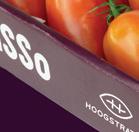

















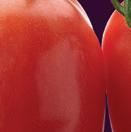


































































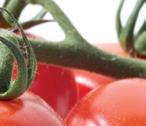








































One of Scandinavia’s leading vegetable suppliers says the recent addition of a Newtec high-speed packing line has helped it to become more sustainable and more efficient.
by Mike Knowles@mikefruitnet
BELOW—The firm’s flowpacked San Marzano tomatoes

Nordic Greens, one of Scandinavia’s largest vegetable suppliers, says the recent delivery of a Newtec high-speed container filler has enabled it to reach new levels of speed and efficiency.
Danish technology firm Newtec has apparently helped to automate the supplier’s operations, minimise waste, and optimise overall performance.
“Production and the various packaging types are streamlined and fully automated compared to before, and the number of employees to handle this process is reduced,” explains Nordic Greens’ Rikke Dybkjær Pedersen.
Nordic Greens grows tomatoes, cucumbers, peppers and salad veg at state-of-the-art greenhouses in Funen, Denmark, and Trelleborg, Sweden.
The company was apparently the first producer in Europe to hand-pick its products and place them directly into trays. That approach, it says, was intended to minimise any damage to the products that might otherwise occur.
So perhaps unsurprisingly, it was concerned that automating the process could damage very sensitive items like tomatoes. That concern turned out to be unfounded.
“The quality of the product has also improved, as there is less handling compared to manual operations, and therefore the process is more gentle on the tomatoes,” Dybkjær Pedersen comments. “The solution is flexible, as we can run several types of packaging simply by changing the se ings.”
Newtec’s technology is apparently versatile enough to enable Nordic Greens to fill a range of different packaging containers, with everything managed via a touchscreen without too much human intervention. Apart from punnets, which can be open or foil wrapped, it also allows the supplier to run buckets and cups with lids through the line – all via flexible dispenser systems and adjustable punnet conveyors.
Dybkjær Pedersen says the machinery has helped the company boost its environmental sustainability too, by enabling it to reduce its use of plastic, cut waste, speed up operations, and consume less energy.
“Sustainability and climate considerations are always high on our agenda in all our phases of production,” he says. “This means that we use recycled cardboard and 100 per cent recycled and reusable plastic, although it is not always the cheapest solution.”
Nordic Greens is a co-founder of Denmark against Food Waste, whose objective is to cut food waste by half in the food sector by 2030. In fact, the company says it has achieved the UN’s Sustainable Development Goal on food waste reduction ahead of target.



























































































Autonomous climate and irrigation management can benefit growers and greenhouse companies in multiple ways, according to Ronald Hoek, chief executive officer of Blue Radix.
by Carl Collen
What role does Blue Radix play in the tomato sector?
Ronald Hoek: Blue Radix is a specialist and market leader in autonomous growing. We develop and implement algorithms for daily processes in greenhouses around the world. With AI we support growers to optimise their climate, irrigation and energy management.
Working with Crop Controller, growers can manage more hectares, while improving yield and significantly reduce the usage of resources like energy and fertiliser. We have 35 employees based in Ro erdam and have customers in 15 countries across four continents.

ABOVE—Crop Controller helps growers manage more hectares, while improving yields and using fewer resources
LEFT—Ronald Hoek, CEO of Blue Radix
offer an integrated solution for autonomous climate and irrigation management. This reduces the work for growers behind the climate computer by 80 per cent. This time and mental a ention can now be transferred to time in the greenhouse and to labour.
You operate in autonomous greenhouse management. What are your key products?
RH: Crop Controller is the system for autonomous climate and irrigation management. The grower defi nes the strategy and the goals for the season. The grower is in charge of what has to be realised. With Crop Controller we support the grower in a number of ways.
What developments have you seen across the category?
RH: The horticulture industry is growing year by year. At the same time skilled and experienced growers are becoming scarce due to ageing. The average age of growers in North America and Europe is 59. In Japan it’s 68. This is limiting the growth of the industry. Greenhouses are complex systems that demand professional high-end management. Working with AI can provide an answer to this challenge, while it also improves the accuracy, yield and predictability of produce.
As Blue Radix we are commi ed to contributing to the resilience, sustainability and growth of the industry. With Crop Controller we
It structures the crop strategy, so it’s a realistic calculation of yield expectations. Typically every week the grower checks if the strategy is OK, based on crop registration and observations. Crop Controller takes care of the execution, 24/7.
Growers benefit from Crop Controller on multiple levels. It’s a win-win for both the growing team and the greenhouse company. Growers have a be er work-life balance, because they don’t have to pay so much a ention to the climate computer se ings. These time-consuming tasks are done by AI/Crop Controller. They can manage four times more hectares, and/or spend more time in the greenhouse and work with the labour force.
The company benefits from higher yields (up to 10 per cent) and a reduction in resource usage (fertilisers by up to 10 per cent, energy by up to even 15 per cent), providing improved profit.
Finally, the company benefits from improved yield prediction and securing the valuable, unique crop knowledge of the company, with less dependency on individual growers.









Swedish retailer teams up with Swedish Growers Association to develop 10ha facility that will ultimately supply 8,000 tonnes of tomatoes per year.
by Mike KnowlesSwedish retailer ICA has revealed it plans to source more locally grown tomatoes later this year from a new greenhouse facility west of Stockholm.
The group said it was investing “heavily” in the 10ha production centre in in Frövi, near Lindesberg, in collaboration with Svenska Odlarlaget, the Swedish Growers Association. The facility will use waste energy from nearby industry for its heating and is expected to supply 8,000 tonnes of tomatoes per year. Its first harvest is scheduled for autumn 2024.
The investment should enable ICA to increase the proportion of Swedish-grown tomatoes in its central supply all year round, and therefore enhances Sweden’s selfsufficiency in fresh produce.
“We want to contribute to strengthen the Swedish food supply and our investment in Swedish tomatoes is an example of how @mikefruitnet


we can do that,” commented Eric Lundberg, CEO of ICA Sweden.
“The investment means that we undertake to increase responsibly the supply of Swedish tomatoes. It benefits both the environment and long-term sustainable Swedish agriculture, while at the same time meeting consumer demand.”
According to a Sifo survey conducted by ICA and LRF in May 2023, there is strong demand among Swedish consumers for food produced in the country.
The research suggests around half regard homegrown products as a way to reduce dependence on


imports, while one-third see it as a means to “strengthen Sweden’s preparedness”.
But a large proportion of Sweden’s tomato supply is imported each year. ICA said it wanted ultimately to offer consumers Swedish-grown product for twelve months of the year.
“Our goal is always to offer Swedish in season,” said Jonas Andersson, business area manager for fruit, vegetables and flowers. He revealed that ICA had increased the proportion of Swedish-grown vegetables in its range by 5 per cent over the past year.
“Today, around 60 percent of our vegetable assortment is from Sweden. Through the collaboration with the Swedish Growers’ Association, we are taking another big step forward in this work.”
ABOVE—The new facility near Stockholm is expected to produce around 8,000 tonnes of tomatoes every year


With

GOLD SPONSOR
Fokker Terminal Netherlands
































Providing with the best technology and innovation strategy in the production of plastic film for vineyards covering.
DO YOU WANT TO KNOW MORE ABOUT US? VISIT > serroplast.it

The country’s citrus industry will increase exports this year under challenging circumstances, with major issues still unresolved.
by Fred Meintjes
Citrus exports from South Africa kicked-off in earnest last month, with shipments of lemons, grapefruit and early soft citrus dominating, and the industry is preparing for yet another rise in volumes.
“Overall, an increase in export volume is expected,” confirmed Citrus Growers’ Association (CGA) chief executive Justin Chadwick. “This is a testament to the resilience of South African citrus growers, producing more citrus under challenging circumstances, such as steep increases in input costs, load shedding and deteriorating public infrastructure. This increase
is also a result of younger trees coming into production across several regions.”
The CGA’s first forecast said that 37.9m cartons of lemons would be exported, an increase of 7 per cent year-on-year.
“This continues the upward curve of lemon exports, which has more than doubled since 2016,”
LEFT—Orange exports are expected to increase this season
OPPOSITE—Lemon shipments could rise by 7 per cent on last year
Chadwick outlined.
Orange exports are also expected to increase, with predictions showing 4 per cent growth in Navels at 25.6m cartons.
“After two years of suppressed Valencia orange exports, production is likely to improve in 2024 and return to the long-term trajectory,” he continued. “This will result in an increase of 12 per cent to 58m cartons.”
However, the CGA’s Orange Focus Group highlighted that substantially higher returns were expected for fruit supplied to local processors, and that exports could be reduced by as much as 5 per cent which could affect the overall forecast.
Grapefruit exports are also expected to increase, back up to the long-term average. The predicted rise of 14 per cent on last year will move the category to 16.7m cartons.

“The increased export volume can partly be ascribed to processing fruit once again being exported to China, which was not the case last year,” Chadwick noted.
37.9m lemon cartons forecast for export
The Satsuma season was likely to close around the 1.7m mark, 16 per cent more than last year, while Clementines and Novas are set to reach 5.4m cartons (up 8 per cent) and 4.5m cartons (up 8 per cent) respectively, CGA noted.
Meanwhile, the association said it was too early to predict the late mandarin crop and a full estimate would be available later in the season.
“While the increase in predicted export volumes for the 2024 season places the industry on a stronger trajectory to achieve its long-term goals, severe challenges remain,” Chadwick added.
While there will be growth in South African citrus exports this year, the industry faces some formidable challenges.
High on the list is the ongoing stand-off between the South Africans and the European Union over phytosanitary regulations regarding citrus black spot (CBS) and false codling moth (FCM), as well as inefficient logistics across the country’s port and rail networks.
“The European Union’s discriminatory and unscientific phytosanitary regulations regarding citrus black spot (CBS) and false codling moth (FCM) is a serious threat as it could lead to South Africa being denied access to the European market,” said Chadwick.
The EU accounts for more than one-third of South African citrus exports and the ongoing saga is causing much concern among growers in the industry.
During the 2023 export season Southern African citrus growers packed 165.1m cartons for delivery to global markets. While this was an increase of approximately 800,000 cartons on the packed figures of the previous year, it was substantially below the long-term
anticipated growth curve.
“The industry can potentially reach the target of 200m cartons in the next four years, and possibly 260m cartons by 2032,” Chadwick noted.
In terms of the EU dispute, the CGA said that given the high stakes involved, it hoped the South African government would soon call for the establishment of an independent World Trade Organisation (WTO) panel to adjudicate on the FCM matter.
“On CBS it is essential that the government calls for a WTO consultation process,” Chadwick confirmed.
If the CGA is hoping that this process will move forward quickly in the months ahead, it may be disappointed. It is election season in South Africa and for the first time in 30 years the governing ANC party is under threat of losing its overall majority. It is a fierce battle, and it is unlikely that those chasing votes will see the EU issue as a priority which must be addressed before the peak citrus season this year.
“Inefficient logistics also remains a major concern,” Chadwick continued. “Congestion at the ports has been holding back growth in the citrus sector and the South African economy at large. Transnet, in collaboration with industry stakeholders, has been addressing port efficiency in the past months and will continue unabated to do so. But the fear still remains that equipment breakdowns and related disruptions might influence exports this season.”
The CGA said that it viewed the expeditious introduction of the appointed private operator of Durban’s Pier 2 container terminal, International Container Terminal Services as critical.
“Any delays in the expansion of private sector involvement in port logistics will in effect imperil


the export economy,” Chadwick noted.
There is, however, also reason for optimism for the season.
“The CGA remains cautiously hopeful about the coming season,” he said. “Recent successes for the industry ahead of exports kicking off include the entry of global liner shipping company, HapagLloyd, into the SA shipping market, as well as the expansion of the shipping options offered by global company MSC.”
Meanwhile, it has been announced
that Gerrit van der Merwe is taking over as chairman of the CGA. Van der Merwe is managing director of citrus grower-exporter ALG Estates (ALG), based in Citrusdal in the Western Cape.
“He brings a lot of energy and enormous experience to this essential role,” said Chadwick.
“He knows the business of citrus through and through. His leadership will be appreciated.”
Reacting to his appointment, Van der Merwe highlighted poor logistics and market access as two key challenges.
“Our rail network and ports
BELOW—The industry is cautiously optimistic despite the challenges
need to be much more efficient and unfair EU trade regulations need to be fought,” he said. “These two obstacles are standing in the industry’s way. As chairman I have a team of dedicated and talented CGA board members behind me. We are all focused on ways in which we can work with government to make sure the industry will firstly retain and then increase jobs and revenue.”
Outgoing CGA chairman Hannes de Waal, from the Sunday’s River Valley in the Eastern Cape, will now become one of the two vice-chairmen at the CGA.
The other is Jan-Louis Pretorius, from Letsitele in Limpopo in the north of South Africa.
Van der Merwe said that being part of a family agribusiness, he felt a great responsibility of stewardship.
“You must aim to leave an endeavour in a better state than how it was entrusted to you,” he said. “Not just in terms of finances and assets, but also in terms of improving it by focusing on the wider community.”
He noted that a citrus farm, just like the industry, was made up out of a collection of hard-working people, people who believe in contributing to the South African economy through working the land.
“It is one of my goals to make citrus more communitycentred and hopefully contribute in that way.”
This sense of community and unity was on display in July last year when a devastating flood caused damage of nearly R500m to growers in the Citrusdal Valley.
“All role-players came together to rebuild and look towards the future,” Van der Merwe added. E






























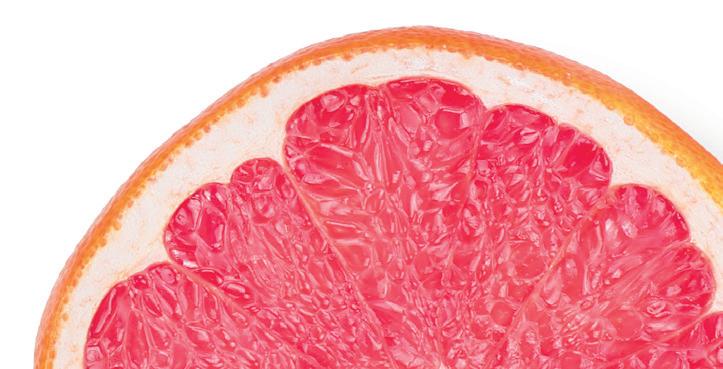





CEO Antonio Alarcón outlines the company’s expansion plans and explains how venture capital funds have breathed new life into Spain’s citrus sector.
by Maura Maxwell @maurafruitnetBELOW—Antonio Alarcón, CEO of Bollo Natural Fruit
OPPOSITE—Bollo is one of Spain’s top three produce companies, with an annual sales volume of around 500,000 tonnes

Since the last time we spoke, The Natural Fruit Company has merged with Bollo International and is now known as Bollo Natural Fruit. Can you talk us through the thinking behind this?
Antonio Alarcón: There are more than 100 years of tradition behind the Bollo brand, which is recognised by both consumers and professionals in the sector for the excellence of its fruit, especially for its melons, watermelons and citrus. It operates in more than 50 countries with a wide product offering. Incorporating a company like Bollo and its management team into the group, bringing their huge knowledge of the product and focus on quality, undoubtedly adds value to the project that we began in 2019.
Can you give us an overview of the company's current production footprint?
AA: Bollo Natural Fruit has around 10,000ha of own production in Spain, mainly distributed between the
Valencia Community, the Region of Murcia, Castilla la Mancha and Andalusia. In addition, we have our own farms in Brazil and Senegal, with which we cover the melon and watermelon off-season. This makes us one of the top three Spanish produce companies, with a sales volume of around 500,000 tonnes per season.
Do you plan to expand your presence in the Southern Hemisphere as part of your yearround supply strategy? How important is it for you to have your own production in regions such as South America and southern Africa…or are you content with sourcing products from third parties?
AA: Our commitment to customers is to offer them the best fruit available during 12 months of the year. To achieve this, we have production programmes with local farmers in both hemispheres, which allows us to maintain our high level of service even when there is no product in Spain.
Logically, as Spanish farmers, we try to extend the local campaign as much as possible, always giving priority to the quality of the product.
Citrus and melons make up the bulk of your business. Are you planning to expand your product offering?
AA: Citrus, melons and watermelons are the main products we sell. However, we offer an extensive fruit catalogue to our customers throughout the year. Mangoes and grapes are the latest additions to our basket. Our mission is to offer fruit of the highest quality, marketed under the umbrella of our Bollo and Bruñó brands.
Spain’s citrus sector faces some major challenges: the availability of water in the south and the proliferation of inefficient smallholdings in Valencia to name just two. At the same time, seasonal overlaps and growing competition from other countries are reducing Spain’s commercial window. Where do you see the best opportunities for Spanish citrus in the future?
AA: Despite the difficulties facing the Spanish citrus sector, there are several opportunities that can help overcome these challenges. Market diversification is essential. At Bollo Natural Fruit we constantly seek to expand our presence in emerging and growing markets, both within
and outside of the European Union. This involves identifying and taking advantage of opportunities in countries where demand for citrus is increasing and where Spain can compete in terms of quality, price and logistics.
It is also important to invest in innovation and technology, for example, through research into the development of new citrus varieties that are more resistant to drought and diseases, or by finding more efficient and sustainable ways to grow our fruit, which could help mitigate the impact of water shortages. We also need to ensure we make optimum use of the water available. At Bollo Natural Fruit, we apply multiple measures to try not to waste a single drop, with the implementation of rainwater collection systems and storm tanks.
The arrival of venture capital funds has transformed Spain’s citrus sector over the last decade. What would you say to those who have concerns about this development?
AA: The arrival of investment funds to the Spanish citrus sector is, without doubt, very positive for the sector for several reasons, one of the main ones being the injection of capital they bring, which helps to modernise operations and increase efficiency and productivity. We’re talking about very expensive investments that are not always possible to undertake without the help of investment partners.
Another positive aspect that comes with the incorporation of funds to the agri-food sector is the promotion of innovation. They encourage research into new, more sustainable agricultural techniques, more efficient management systems…all of this for the benefit of the sector.

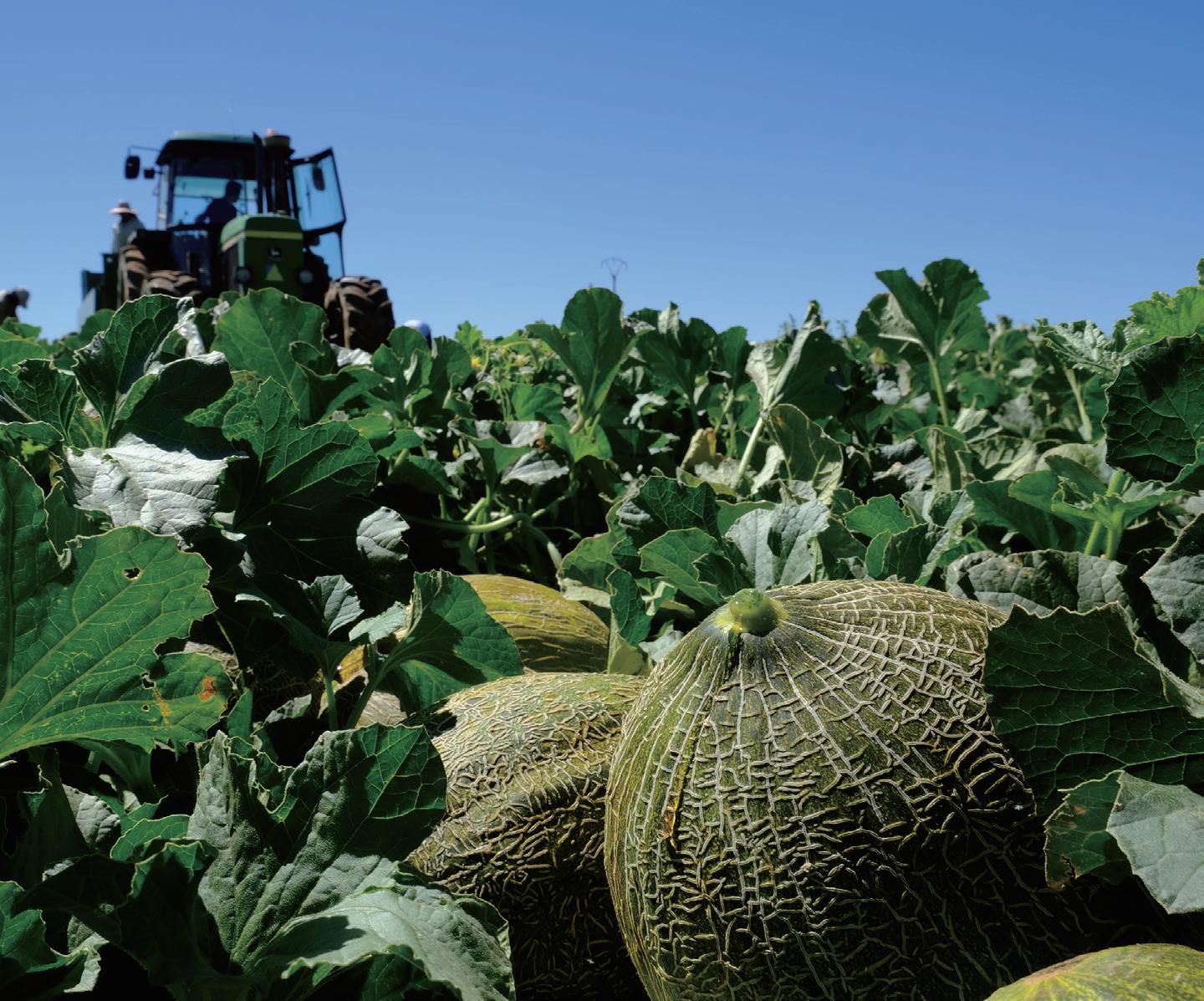
Plus, they help companies to be more transparent. Firms owned by investment funds must maintain high standards of transparency in their management and accountability, clearly communicating their objectives and results to all interested parties.
In summary, the arrival of
investment funds to the agri-food sector is very good news and an opportunity to modernise the industry and make companies more competitive. This will undoubtedly benefit all actors participating in the sector's value chain, from the farmer to the consumer. E
Company says the variety’s post-harvest life, durability, high colouration and firmness make it ideal for markets across Asia, North America, and Europe.
by Maura Maxwell @maurafruitnet

Genesis Fresh hopes to shake up the pigmented orange segment with the launch of Onix, a new variety discovered in Seville that combines high internal and external colouration, an extended post-
harvest shelf-life, durability and an attractive size profile.
“Onix represents a breakthrough in the pigmented oranges segment, surpassing conventional varieties like Sanguinelli by 2-3 calibres,” said
BELOW LEFT—Onix achieves optimal sizing and external colouring earlier than Sanguinelli, enabling earlier harvesting
David Alba, CEO of Genesis Fresh. “What makes the Onix orange a highly att ractive fruit is the combination of an incredible external and internal colouration with a refreshing fl avour and delicate aroma that evokes the traditional Sanguinelli taste.”
According to the company, Onix is characterised by its attractive external colouring and high internal pigmentation, which can be achieved even in challenging conditions. And tests done by the Institute for Plant Molecular and Cellular Biology (IBMCP) in Valencia demonstrate that the orange is scientifically proven to contain high levels of anthocyanins at optimal ripeness.
“While Onix and Sanguinelli are comparable in organoleptic quality, Onix excels by achieving optimal size and external colouring earlier, enabling earlier harvest,” said Alba. “Moreover, Onix exhibits exceptional on-tree endurance and outstanding post-harvest life, extending its sales window to approximately 4-5 months in each hemisphere.”
Alba said the variety is ideal for markets across Asia, North America, and Europe thanks to its post-harvest life, durability, high colouration and firmness.
Patricia Sagarminaga, global director marketing & communications at AMFresh, commented, “The Onix brand embodies innovation and quality, offering consumers a naturally branded fruit that is truly 'out of this world, made in Spain.'
“The elegant, innovative branding and positioning of Onix within the citrus and fresh produce space have resonated with consumers across European markets, driving remarkable in-store sales performance as shoppers seek a sense of discovery amidst the ordinary.
“Furthermore, to experience the versatility of Onix, we invite shoppers to visit the Onix website where AI-powered algorithms generate personalised recipes for desserts and cocktails, providing inspiration and solutions for curious shoppers.”
The variety has launched in major UK retailers including Tesco and M&S, as well as Spain’s Eroski and Germany's Rewe and Kaufland. It is available as both a loose fruit retailing at £1 a piece (in the case of the UK) or packaged in 3 or 5-piece sets. Despite its limited availability this season, AMFresh said the response “has been nothing short of phenomenal”. E
After many setbacks, Florida citrus grower Doug Feek is building back better.
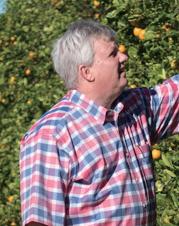 FDOUG FEEK Feek Family Citrus Managing partner
FDOUG FEEK Feek Family Citrus Managing partner
lorida still has the best fruit in the world due to our aroma. When you cut a Florida Valencia orange or grapefruit, the fruit explodes with juice, flavour, and aroma. Yes, we have been beat up as well. There has been a loss of production due to a number of reasons. The real estate market, canker, greening, aging trees, and discouraged growers are a few big ones. Hurricanes are another.
The industry has not been able to get a real commitment from the USDA on financial assistance to help with the crop and tree losses due to the most recent hurricanes. To replant takes a commitment of 7-10 years before we see the results from ordering the new tree. So some growers have decided to only replant the better areas or to not replant at all.
For the 2023/24 season, we are still recovering from our last hurricanes and our production numbers are still not what they should be. However, we are seeing improvements. We see a strong bloom for the upcoming season which indicates our growing situation could be back on track. Demand is good with prices increasing. As growers, we need these higher prices to help us to
BELOW—Feek is hoping for good prices this season to make up losses from previous campaigns
recoup our losses from the past few seasons and to help pay our increased growing costs.
We start our harvest with grapefruit, Early Gold oranges, Navel and Fallglo and Early Pride tangerines at the end of September. In November we switch to a Hamlin orange when the brix levels are around 10 and ratios are above 14. We also switch from Fallglo and Early Pride to our Sugar Belle tangerines. In January, we usually finish our Navels and change from a Hamlin orange to a Pineapple mid-season orange. We also switch from Sugar Belle to Honey tangerines.
By the end of February, we finish with our Honey tangerines and change from a mid-season Pineapple orange to the world famous Valencia. We finish our grapefruit season at the end of March or early April and continue with Valencia through to July.
A Valencia orange from older trees will produce fruit at the end of March through April that has a flavour that cannot be replicated anywhere in the world. During that period, we harvest and process as much fruit at this peak as we possibly can and when we ‘ve finished harvesting we continue with our coldstorage programme, adding another 8-10 weeks to our season and allowing us to service our customers for longer.
It's true that Florida has been hurt with some poorquality fruit over the years. I feel like for the most part growers are past this stage and concentrating on rebuilding our brands. Many of us are replanting and growing for the future.
At Feek Family Citrus we are continuously reinvesting and have made some very large commitments for our future growth. We are replacing all old trees and have some 65,000 new trees going in the ground over the next two years; we have invested in our new coldstorage, and every season we expand with new automation in the packing house. We also started hauling our own fruit from the fields to our packing house and the juice plants.
And our final commitment to our future is the next generation. My daughter Jordan has been working in the business for the past three years, and my son Jared started this year. Our whole family is dedicated to working and improving the Florida citrus industry. E

Times are tough for the country’s lemon sector, but Salix Fruits has seen its own programme grow year after year.
by Maura Maxwell @maurafruitnetExcess offer and low profitability have led to a significant decline in lemon acreage in the Argentine province of Tucumán this year.
Against a backdrop of rising production costs and rapidly increasing global supply, a number of growers in the north-western province – home to around 90 per cent of the country’s lemon output – have been unable to adequately maintain their trees, while others have been forced to abandon their farms altogether.
Until a few years ago, Tucumán had 46,000ha of lemon production, but in the last four years around 15,000ha have been razed and another 12,000ha are in a state of abandonment.
According to government figures, Argentina produced 1.77m tonnes of lemons last year, down from 2.1m tonnes in 2022. The bulk of this (1.4m tonnes) went for processing, with another 200,000 tonnes sold on the domestic market.
Last year exports of fresh lemons totalled 220,060 tonnes and had a corresponding value of US$124m, down from 258,449 tonnes and US$160.8m in 2022. Around 55 per cent of this went to the European Union, with further 35 per cent being shipped to the US.
However, Argentina has seen its market share in Europe slide
since the start of the decade due to strengthening competition from South Africa, Spain and Turkey, all of which have seen a notable increase in their planted area.
“The Argentine lemon industry has been in crisis in recent years due to a general lack of competitiveness,” says Alejandro Moralejo of Salix Fruits. “Its once dominant position in many markets is today under threat, despite the excellent quality of its offer.”
Dollar inflation has hit Argentina’s competitiveness hard, while the increase in ocean freight prices in 2021/22 significantly affected the profitability of Argentina along with other Southern Hemisphere suppliers.
“In addition to this, phytosanitary barriers generate greater difficulties and extra costs when it comes to accessing markets,” Moralejo says.
Argentina also faces a lot more competition in the Northern Hemisphere summer window. Spain and Turkey are increasing their output and Egypt and Morocco have joined the fray, leading to market saturation.
In Asia, meanwhile, China dominates supply to its internal market and also ships to other countries in the region, as well as to Russia and the Middle East.
Similarly, South Africa has seen a big rise in production, while Chile has carved out a very lucrative niche in premium price markets such as Japan and South Korea.
The result, says Moralejo, is an oversupply of fresh lemons across all Northern Hemisphere markets for what is, in the end, a very price inelastic product.
Yet against this gloomy backdrop, Salix Fruits has seen its own Argentine lemon programme grow steadily each year. The company is one of the biggest importers and distributors of this product in the US. From its offices and warehouses in Philadelphia, it supplies its retail, foodservice and wholesale customers with Argentinean lemons from the second week of May right through to the end of October.
“Our programme is growing every year, since in addition to our significant presence in the US, we also supply Europe, Canada, Russia and Asian countries such as the Philippines and China,” says Moralejo. E

The effects of El Niño have receded, but the longer-term outlook remains uncertain, says Sergio del Castillo of ProCitrus.
by Maura Maxwell @maurafruitnet
Agood quality crop and favourable size profile augur well for the 2024 Peruvian citrus deal, but the longterm outlook for the industry remains uncertain according to industry body ProCitrus. General manager Sergio del Castillo says the impact of El Niño has been minimal, although it has brought forward the harvest somewhat this year. He expects overall export volumes to be up 5 per cent on 2023.
“The new export campaign began in March,” he tells Eurofruit “We have less fruit in the early varieties such as Satsumas, Primosole and Nova, while Clementine production and later varieties like Nadorcott and Tango are up slightly. And we have a
lot of large sizes following the accelerated growth that the fruit has experienced due to the high temperatures that occurred last year.”
Exports are on course to bounce back after last year’s El Niñorelated downturn, reaching similar levels to 2022 at 270,000 tonnes. Del Castillo says that the campaign will be more extended due to the multiple flowerings that occurred last spring. “We estimate that it will run until the end of September of this year.” he says. “Last year we experienced a 5 per cent drop in our export volume and this year we will recover it.”
While Southern Hemisphere citrus production has been hit generally by last year’s climatic
BELOW Sergio Castillo,Chilean citrus exports are forecast to reach 383,000 tonnes in 2024, a decrease of 4 per cent on last year, according to the latest figures from the Chilean Citrus Committee.
Clementine and mandarin exports are set to fall by 35 per cent and 9 per cent to 40,000 tonnes and 160,000 tonnes respectively, while oranges are down 2 per cent at 93,000 tonnes. Lemons have bucked the trend, with a projected rise of 33 per cent, giving an export volume of 90,000 tonnes.
Monserrat Valenzuela, manager of the Citrus Committee, said the clementine shortage was down to water restrictions in the Coquimbo Region, Chile’s main clementineproducing area. According to data from Ciren, Chile has around 4,000ha of clementines, 70 per cent of which are concentrated in Coquimbo.
Juan Ortúza, president of the Citrus Committee, commented: “We are building an industry better adapted to climate change, with a strategy aimed at facing new productive challenges, and with a focus on more sustainable production”.
problems, Del Castillo estimates that the rise in new plantations in South Africa will keep supply at similar levels to last year. Overall, he anticipates relatively good prices due to the shortage of fruit from the Northern Hemisphere.
Looking further ahead, however, he says Peru faces an uncertain future. “Investment in this sector is still halted and the rise in production costs has made many patent-free varieties unprofitable,” he explains.
“The recovery seen in prices is minimal compared to the increase in costs. And although maritime freight rates have fallen significantly, the same has not happened with other costs such as electricity, fertilisers, labour and other inputs.
“The legal and regulatory landscape is also complicated and I do not see this improving in the short term – in short, the outlook has not improved. we hope to see a better regulatory framework for Peruvian agro-exports, which promotes investment in our sector so that we can get back on our previous growth trajectory.” E
Lower volumes could bring more balance to the European market during summer months.
by Maura Maxwell @maurafruitnetAprojected 16 per cent decline in Peruvian Hass avocado exports this year is set to reduce the risk of an oversupplied European market over the summer. According to industry body ProHass, Peru expects to ship around 468,000 tonnes in 2024, down from 558,000 tonnes last year, mainly due to unfavourable climatic conditions and a slowdown in new plantings.
Already this year, prices are 40-50 per cent above levels seen in the same week last year, although only small quantities of fruit have been shipped. This is due to lower output from Mexico, which is just finishing its main campaign,
the smaller California crop and water availability issues impacting production in Spain and Portugal.
With Peruvian volumes set to ramp up in April and May, the hope is that prices will remain firm as we head into summer.
“Last year’s avocado campaign presented us it with a lot of challenges,” Sergio Torres of Camposol tells Eurofruit. “Mexico had a strong season, which didn’t leave much space for other origins like Colombia and Peru in the US market, and this resulted in these countries focusing their shipments on Europe.
“Unfortunately, consumption in the European market is not keeping
pace with supply. Consumption is growing at about 10 per cent a year whereas supply has been increasing by closer to 20 per cent in the past few years.”
Torres says Camposol anticipates “fairly normal volumes” for 2024, with the impact of El Niño dialing down from May onwards.
“Our hope is that the supermarkets will programme continuous promotions to keep demand fluid from the beginning of the season,” he notes.
In addition to its farms in Peru, Camposol has its own Hass production base in Colombia and sources from producers in Spain, Portugal and Morocco to complete its year-round supply.
According to Torres, the company is working hard to boost productivity levels at its Colombian farms to enable it to be more competitive in the market. He admits it has been a steep learning curve.
“Colombian yields are lower than in our Peru farms. We need to improve them by fine-tuning our production techniques – it’s all about better management and training,” he says, adding that the company has brought in a team of agronomists from Peru to oversee the project.
Camposol currently has 1,350ha of avocado production in Colombia, with another 1,000 ready to go. According to Torres, the plan is to increase productive acreage by around 200ha per year.
Meanwhile, the expansion in Peruvian avocado acreage appears to have stalled. According to ProHass, acreage was growing by 12-15 per cent year-on-year, but this has virtually stopped due to a number of political, financial and logistical factors. E
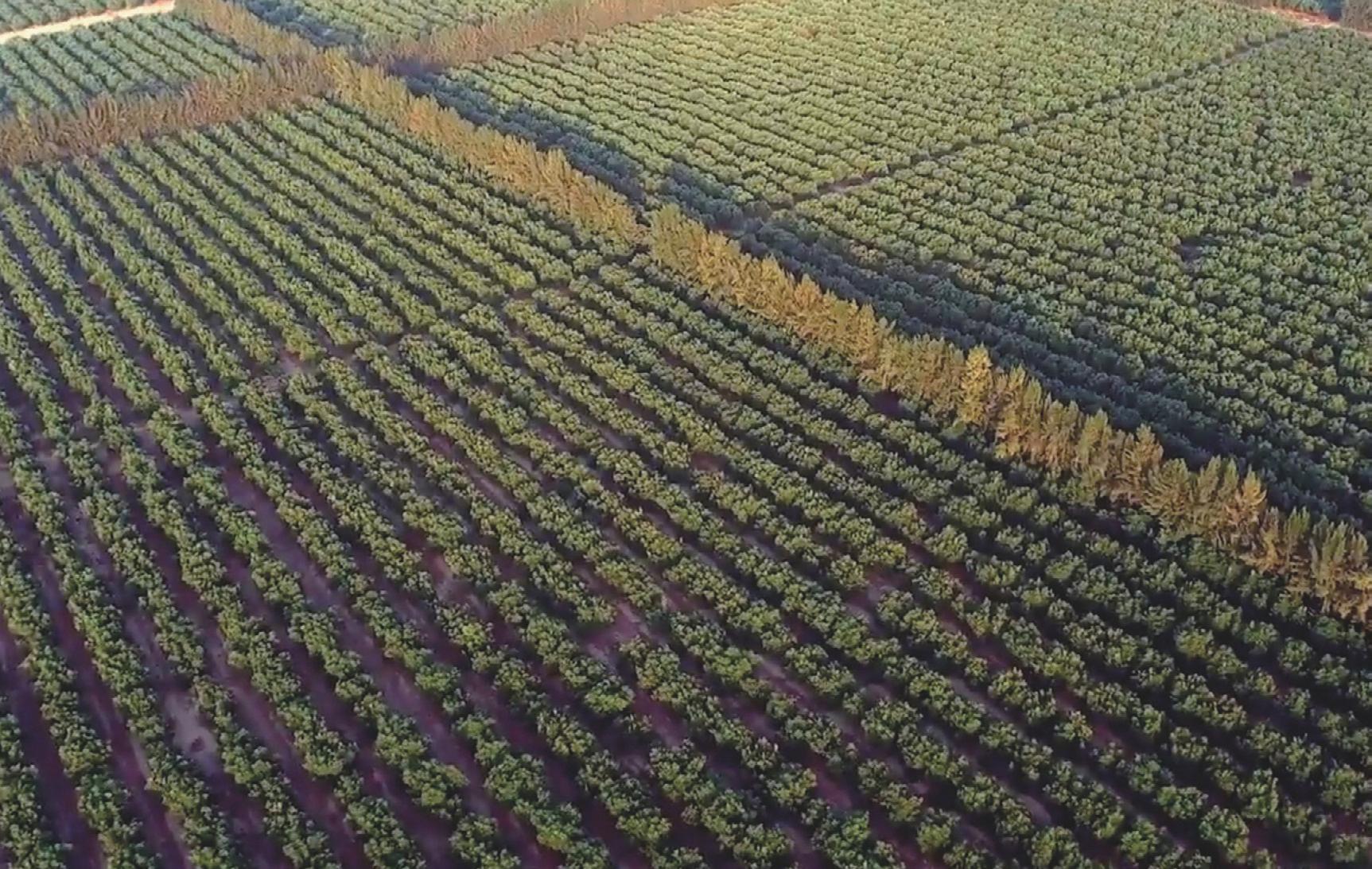


 AMILLER PRECIADO
Elite Blu Operations manager
AMILLER PRECIADO
Elite Blu Operations manager
s an agronomist with 19 years of experience in Colombia's vibrant agricultural sector, I have been involved in the development of many agro-industries and the generation of equity in rural areas, always focused on sustainable production.
However, my approach has evolved to understand that actions in the rural sector also have a profound impact on reducing poverty and improving economic conditions, which translates into equity for my compatriots and for the development of the country.
Twenty-four per cent of Colombia’s population lives in rural areas and more than 3.5m people work directly in agriculture. So the challenge is to identify crops that create jobs and improve rural life indicators. Currently I cannot think of a crop that satisfies these intentions better than blueberries. The technical package that we have developed allows us to provide decent employment to more than six people per hectare of permanent cultivation. If we consider that in our country blueberries can be grown through 52 weeks of the year, this allows us to supply all the market windows during the year.
Colombia’s blueberry history began approximately 25 years ago, when the first planting materials arrived in the country. The first attempts to cultivate the berry centred on the Biloxi variety, but the process was not yet technical. The great blue dream remained dormant for more than 15 years, until in 2017, more structured planting projects began to spring up in the departments of Cundinamarca and Boyacá, ideal regions for the production of fruit trees due to their ready availability of water and concentration of labour.
Today those regions host the largest area planted with blueberries in the country. We have gone through a steep learning curve that has required us to overcome many challenges, but we are now at a point where we can affirm that the blue dream in Colombia has truly begun.
In my role as manager of the most important blueberry production company in Colombia, I have consolidated the export operations of this fruit and adapted the crop management plan to the
ABOVE—Colombia planted its first blueberries around 25 years ago
conditions of the high tropics, allowing us to produce for 52 weeks of the year. (I know that for many readers it is complex to understand, but in my country we are in eternal spring, while also having the necessary cold hours to send the message to the plants to bloom permanently).
At the end of 2022, Colombia’s blueberry cultivated area stood at 600ha. We are still in the process of updating the information for 2023, but what we do know is that 2024 will be a year of expansion.
Among the varieties that have shown the best performance are Biloxi, Ventura, Victoria, and Emerald. We have also started projects to introduce premium materials from all the Breeders present in Latin America.
Planting densities vary from 5,500 to 9,000 plants per hectare, depending on the variety. The average Brix we achieve at harvest is 13.4o, which gives our blueberries their distinctive sweetness and flavour. This sweetness allows us to organoleptically enhance the development of the berry and establish market niches that »

value the balance between acidity and sweetness.
Productivity per hectare has the potential to exceed 30 tonnes, thanks to a production model focused on the management of the same plant during 52 weeks of the year. With programmed pruning, we have established a method called "evergreen" that achieves a balance of all the physiological phases of the crop, allowing a plant to deliver fruit every eight days throughout the year.
Current performance on promising materials like Emerald, under our conditions, has shown impressive production potential. We are achieving a productivity of 2.2kg in the first year of production, 4.26kg in the second year, forecasts of up to 5.8kg in the third year and stabilising with values higher than 6.5kg per year starting in the fourth
year. These results are indicative of the potential that Colombia has to become a key player in the global blueberry market.
Moreover, Colombia's strategic geographic location offers a unique advantage: facilitating faster access to international markets. This is particularly relevant for exports to the US, which is currently our main trading partner in the fruit sector. However, it is crucial to also recognise the growing opportunities in Canada, a significant emerging market for our products.
Regarding the conquest of that market, in the first days of 2024 we made our first test shipment of blueberries to Canada. Establishing the protocol for exporting to that country was a key achievement of 2023. This advance not only marks significant growth in the
Blueberry cultivation has the potential to create jobs and improve lives in Colombia’s rural communities
development of the sector, but also opens doors to new consumers. I am confident that the Colombian blueberry, recognised for its unique attributes and its transformative socio-economic impact on Colombian rural areas, will become the favourite of our current and future customers.
It is clear that we are now living a blue dream, a huge opportunity to promote the development of blueberry cultivation in Colombia under the premise of differentiation by flavour. We have the land, the people and the water that allow us to dream of exponentially increasing our planted areas and thereby giving rural people the opportunity to have decent and stable jobs.
I invite you to join Colombia’s blue dream, to help us develop and provide opportunities to a country with a high agricultural vocation and a high development potential. This will allow our agricultural production to shine and will confirm the impact that development generates on the reduction of poverty and increase of equity in a country where these are essential. E
ABOVE LEFT—Miller Preciado of Elite Blu, Colombia’s leading blueberry export company














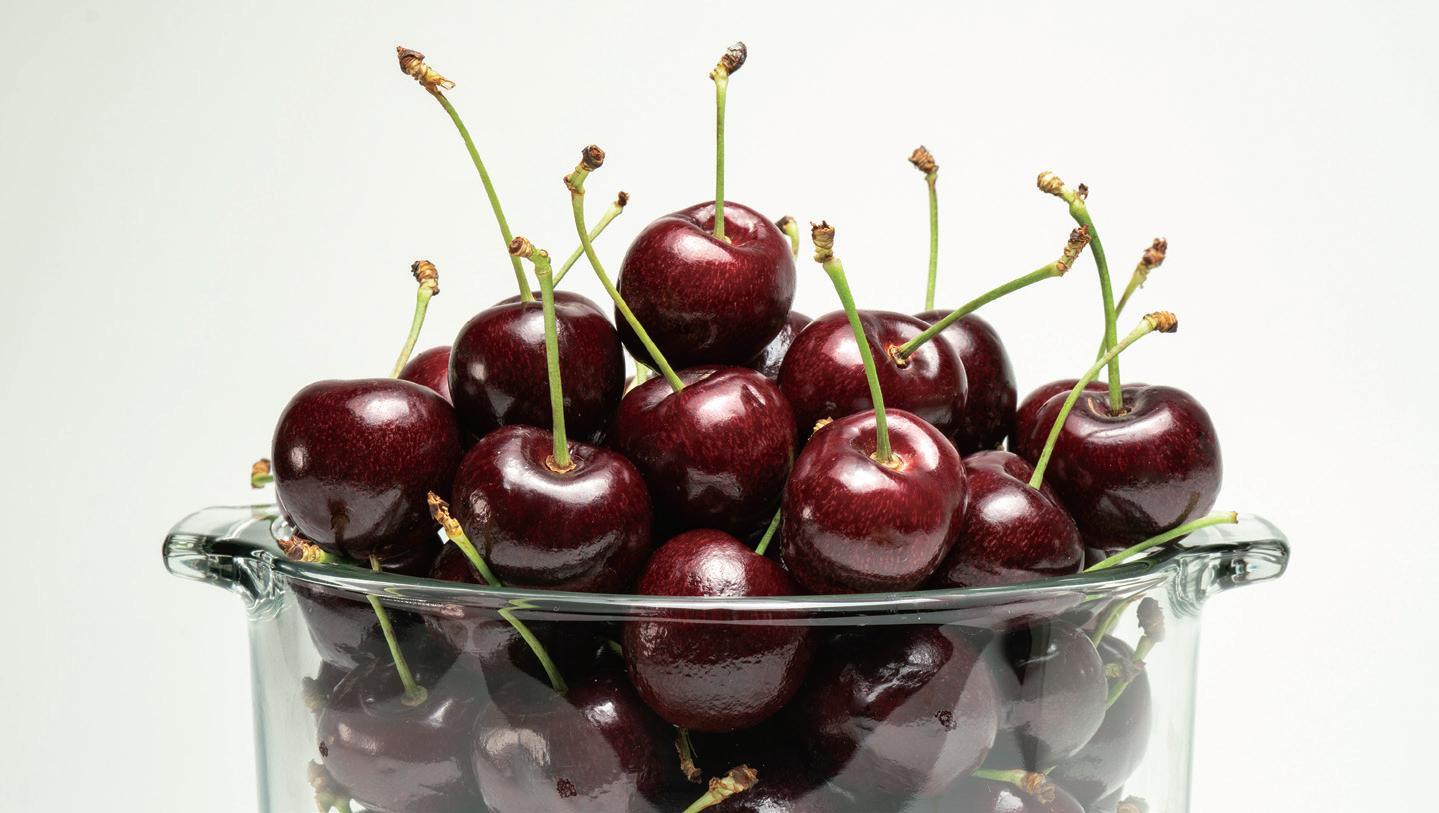
Committee reports record-breaking season in China, but shipments to non-Asian markets down.
by Maura Maxwell @maurafruitnetChilean cherry exports remained broadly flat in 2023/24, but exports to China hit a new record, according to the Chilean Cherry Committee.
As the season drew to a close, it said 413,979 tonnes of cherries had been shipped worldwide, 0.3 per cent down on the same period last year. Exports to China stood at 377,000 tonnes, 3.3 per cent above last season.
The commi ee’s executive director, Claudia Soler, said the season had been positive overall. “In general, we can say that this was a good season, because our cherries were well received by consumers, which allowed the fruit to rotate well, despite the fact that in the first part of the campaign exports showed a decrease of volumes due to the spring rains,” she commented.
Despite the rains, she said the early fruit had arrived on the market in good condition and with high quality because exporters had prioritised air shipments. Midto late-season exports were not impacted by the rains.
Asia received 388,062 tonnes of cherries, a growth of 1.5 per cent on last year. But shipments to all other markets decreased. In the case of the US East and West Coasts were down 14 per cent and 52 per cent respectively, totalling 13,977 tonnes.
Exports to Latin America totalled 7,296 tonnes (-20 per cent), Europe reached 3,850 tonnes (-17 per cent), Canada 685 tonnes (-36 per cent) and the Middle East with 109 tons (-61 per cent).
The top 10 varieties of cherries shipped were: Lapins with 43
per cent of the total, Santina (21 per cent), Regina (19 per cent), Sweet Heart and Bing with 4 per cent respectively, Kordia (3 per cent), Skeena (2 per cent), Royal Dawn and Rainer with 1 per cent.
In total, Chile sent more than 36 varieties of cherries to the world. This included small quantities of new early-season varieties such as Meda Rex, Sweet Aryana or Royal Lynn, among others, which are still produced in low volumes.
This season saw a notable growth in airfreighted shipments, particularly in the case of China, which received 15,000 tonnes of airflown Chilean cherries, an increase of 4.4 per cent on last season.
Iván Marambio, president of Frutas de Chile, said: “Without a doubt, this cherry season showed, once again, that the Chilean fruit industry is capable of facing the challenges, because although we had some setbacks such as the lack of cold in winter and spring rains, we were able to send quality fruit”.
For the first time, Cherry Express vessels discharged at the Port of Tianjing. This entry point is understood to offer considerably easier access to northern parts of China, particularly Beijing and its surroundings.
This season also saw the first vessel carrying cherries reach India, in a record time of 36 days and a single stopover. “This makes us optimistic about how we can develop this market, especially considering that we entered it with zero tariff,” Marambio said.
Soler noted that the sector must not lose sight of the fact that “China is a dynamic market with significant growth potential, which requires us to be constantly a entive to the changes that this market has, as well as deepen its development, stimulating greater consumption in regional cities and charming the youth segment that has a lower consumption of cherries”. E
Shipments increased by more than 40 per cent in the 2023/24 campaign.
by Maura Maxwell @maurafruitnetCherry exports from Argentina’s Rio Negro grew 43 per cent in 2023, reaching 1,846 tonnes, according to data from the Argentine Chamber of Integrated Cherry Producers (CAPCI). The figures reflect an increase of around 11 per cent on the average for the past five years, but are short of the record 2,365 tonnes shipped in the 2020/21 campaign.
The region’s production is mainly concentrated in the Valle Medio, which accounts for 95 per cent of the export total.
“This season production was affected by the hailstorms and rains that occurred in December. This resulted in much of the
fruit that was originally destined for export being diverted to the domestic market,” a local source said.
Around 25 per cent of the crop was exported this season, compared with 39 per cent in 2020/21. However, this was partially offset by an increase in exports from Neuquén and Chubut.
According to the latest data provided by CAPCI, total Argentine cherry exports during the current season reached a record 7,178 tonnes, reflecting a growth of 51 per cent in relation to the previous season. E
RIGHT—Exports were 11 per cent up on the five-year average
Maersk carried out its first-ever airfreighted shipments of Chilean cherries in the 2023/24 season. Between 21 November and the end of December the Danish company chartered five flights, each carrying 500 tonnes of Chilean cherries and with a transit time of 2-3 days.
“This move solidifies Maersk’s commitment to meeting the dynamic demands of global trade and serving our customers through multiple modes of transportation,” the shipping giant said.
“The air service addresses critical needs, helping to save costs by reducing production-to-delivery times and boosting overall sales by ensuring better product availability. It also helps fortify resilience and agility within the supply chain and plays an essential role in securing and elevating customer service standards by facilitating fast, visible and predictable deliveries.”


The quality of peaches, nectarines, apricots and plums produced in Turkey has risen in recent years, according to Mustafa Arslan of MDA Agro, with only strong domestic demand restraining exports.
by Tom Joyce @tomfruitnet
ABOVE—The plum season begins with Black Splendor
This season, on account of the warm weather conditions, flowering in Turkish stonefruit orchards occurred early, according to Mustafa Arslan, owner of Turkish exporter MDA Agro.
“We hope to start with Flored peaches after 25 April,” he said. “We also hope to have a good start for early varieties of nectarine in the first week of May.”
Since the region experienced no adverse weather conditions during the flowering period, Arslan expects the quality to be high this season.
“The apricot season continues
in mid-May with the Mikado and Mogador coloured varieties, and then with Ninfa and Tirintina,” he continued. “Our season in Mersin and its surroundings lasts until the end of June. The plum season starts with Black Splendor varieties for export in early June and continues until mid-August.”
Last year, Turkey produced approximately 800,000 tonnes of apricots, over 1m tonnes of peach and nectarine varieties, and 350,000 tonnes of plums.
“In recent years, our farmers have achieved better quality and production standards by preventing excessive tonnage in production
with dilution and similar practices, correct irrigation and spraying at the right time for better quality and more efficient production,” said Arslan. “By focusing on quality production in a very successful cooperation, farmers and exporters have enabled Turkish fruit to be successfully exported and appreciated by consumers in all markets in recent years.”
However, with the popularity of apricots as a raw material for jams and such products, and with the growth of the frozen food sector in Turkey, the supply of apricots for export is actually decreasing. Meanwhile, according to Arslan, domestic consumption of peaches and nectarines has increased due to the rise in tourism and local tourism in the summer months, and prices tend to remain at a good level.
Last year, Turkey produced 800,000 tonnes of apricots, 1m+ tonnes of peaches and nectarines and 350,000 tonnes of plums
“Despite such a sizeable production, exports last year were impacted by an increase in demand in the domestic market and the growth of the frozen food sector,” Arslan said, “with apricots reaching around 88,000 tonnes, peaches and nectarines 238,000 tonnes and plums 35,000 tonnes. We expect the same volumes to be exported this season. If the markets are good and demand increases, it may be possible to increase Turkish peach and nectarine exports to 300,000 tonnes.”
MDA Agro’s main markets for stonefruit are Russia, the EU, the UK and Ukraine, as well as East Asia, which has been increasing for the company in recent years.
“Demand in the Far East increases every year,” said Arslan, “and the market ranks number one among our targets.” E
The war in Gaza has affected labour availability in Israel, but the fall in stonefruit exports has more to do with rising transportation costs and strong domestic demand.
by Gerry KelmanProduction of fruit and vegetables in southern Israel has been significantly affected following the events of 7 October and the subsequent conflict in Gaza, largely as a result of the impact on labour availability. For this reason, agricultural areas that rely heavily on mechanisation have recovered better in recent months.
There is very little cultivation of stonefruit – peaches, nectarines, apricots, plums and cherries – in the southern areas of Israel, mainly because the climate there does not enable nearly enough chilling hours required for optimum fruit production.

Stonefruit cultivation is based mainly in Israel’s highland areas –Galilee (Western, Central and Upper), the Golan Heights and Jerusalem Hills. The Galilee and Golan areas have been badly disrupted by the “non-war” with Hezbollah along the border with Lebanon where many of the orchards are situated only tens of metres from the border. This has affected the quantities harvested and other essential autumn activities that will be reflected in 2024 yields.
In recent years, the area under shaded cover has increased significantly to combat climatic fluctuations. A combination of very high temperatures and increasing light intensity has, among other things, delayed fruit colouration.
The area cultivated has remained fairly consistent over the last decade. According to data from Dr Anat Zisovitch, extension agronomist for deciduous fruit at the Ministry of Agriculture, peach and nectarine production stands at 4,200ha; plums at 1,500ha; apricots at 760ha; and cherries at 600ha.
Many different varieties are cultivated, both long-standing and recently developed. The overall area remains fairly static, uprooting of old orchards being matched by new plantings. Jewish religious laws decree that fruit produced in new orchards must not be harvested until the fourth year, any fruit produced during the first three years being discarded.
The main target for Israeli stonefruit exports used to be Russia, with the UK being the largest
recipient in western Europe. However, a combination of factors, including Covid-19 restrictions, a significant rise in shipment costs and increased demand within Israel, have contributed to a decline in exports to negligible volumes. Nevertheless, Israeli companies continue to export stonefruit technology and innovative varieties, not least Ben Dor Fruits and Nurseries, a family firm based in Upper Galilee and founded in 1880. The Ben Dor Company has developed, over the last 40 years, innovative varieties that combine earlyand late-maturing genetics with different skin and flesh colours, including red-flesh nectarines and watermelon plums with green skin and red flesh.
In the plum segment, a super sweet fruit (up to 31o Brix) with a crunchy and juicy texture has been developed, such characteristics being preferred in the Asian and Middle East markets. For apricots, Ben Dor has bred and developed highly unusual combinations: Blackot is black on the outside with yellow flesh; Vaiolet is purple on the outside with red flesh; and Tigercot has red stripes on the outside and crimson flesh within.
Breeding director Ido Ben Dor commented: “Varieties developed by the Ben Dor Company are to be found growing in 34 countries worldwide, the genetics being exported from Israel. We have established companies and we cooperate with local nurseries/growers/exporters in various countries that cultivate their own trees to be planted locally, marketing the fruit internationally.” E
ABOVE—Ben Dor’s wide range of stonefruit

The Belgian exporter is intent on boosting its range of products and growing in new markets including the UK, which experienced multiple veg shortages last year.
by Tom Joyce @tomfruitnetBelgian exporter Demargro has its sights set on the UK, aiming to grow its exports to nearby markets as it approaches its 50th year of business.
“Next year, we celebrate the 50th anniversary of this familyrun business,” said the company’s Dominiek Keersebilck. “90 per cent of our turnover currently comes from just five products, so we are looking at both new products and new markets for the future.”
The company’s main products are strawberries, tomatoes, leeks, pears and peppers, which it exports to France, Spain, Poland and Scandinavia.
“Strategically, we decided we had to work on the UK,” revealed Keersebilck. “We expect that the
UK will have to import a bit more in the coming years due to Brexit. There is domestic production, of course, but labour is an issue, and everyone remembers the image of empty shelves from last year.”
Demargro has its own transport company, Argrotrans, with 15 refrigerated trailers, increasing its flexility on shipments. “This is a big advantage for the UK,” said Keersebilck, “allowing us to speed up deliveries. We’re very close to Calais. In an hour and a half, we can be there, and then to Dover it’s another hour and a half. There is a lot of competition, but we want to invest in this market. We are open to cooperation with packers, including the supermarkets. In addition to London, there may also be opportunities to send to Manchester and Birmingham.”
Loose vine tomatoes make up around threequarters of Demargro’s tomato offering, but specialties are on the rise, according to Keersebilck.
“We have some varieties like Ruby Red that are in high demand,” he said. “Large Coeur de Boeuf tomatoes also. And we are starting up some specialities like cocktail tomatoes on the vine that have big opportunities on the UK market. There is a high-end consumer in the UK that is looking for alternatives to bulk products.
“We also have close contact with growers in France and the Netherlands, so we can offer whatever people in the UK want.”
Keersebilck said this could include less-known items like celeriac, as well as forgo en vegetables that are presently experiencing something of a revival. E
ABOVE—Demargro sees potential for Belgian tomatoes in UK
Strawberry volumes from Belgium are rising as the new campaign hits its stride, but the main issue going forward is diminishing returns for growers.
by Tom Joyce @tomfruitnetBelgian cooperative BelOrta is prepared for the new strawberry campaign in Belgium, with the first volumes of the season already on the shelves and peak volumes on their way.
“Last year, the season started late, but we are on schedule this year,” said Miguel Demaeght, sales manager for fruit at BelOrta. “The first growers with heated greenhouses and extra lighting started on around 7 March, but the big volumes will start around week 14.”

According to Demaeght, the giant peaks and troughs of previous years may be a thing of the past, as various factors combine to fla en out volumes.
“The peak months used to be April, May and June, but our growers, through new systems of growing and their choice of varieties, now experience a longer season
without the huge peaks,” said Demaeght. “Our growers have shi ed from June-bearing strawberries to ever-bearing varieties. So we have also good volumes in July, August and September.”
BelOrta is also seeing a continued shi from in-soil production to substrate. “This is due to the availability of land, as well as the practicality of ge ing people and packaging materials to the fields,” said Demaeght. “Growers now use high-tech table-top systems that
“Costs have increased for everything –substrates, plant material, fertiliser, energy, phytosanitary products, labour”
require no soil. Fi een years ago, around two-thirds of our growers produced in the soil; now 80 per cent use substrate. This trend has been gradual. It is partly due to the cost of labour, which is expensive in the strawberry category and accounts for 45-50 per cent of overall costs. You can also get a higher tonnage per hour from the table-top system, as it’s the perfect height for picking.”
When it comes to varieties, Elsanta leads among BelOrta’s growers with 27 per cent, followed by Sensation (20 per cent), Karima and Malling (10 per cent each), Elegance
and Lady Emma (9 per cent each), Verity (5 per cent) and Parlando (3 per cent).
“We have 115 growers in both Flanders and the Netherlands, producing around 12,000 tonnes a year,” said Demaeght. “For us, our home market, selling under the BelOrta name, is hugely important. 40 per cent of our strawberries stay in Belgium, with 60 per cent exported to markets including the Netherlands, Germany, the UK, France and Scandinavia.”
A huge challenge for strawberry growers in Belgium remains high costs, but supermarkets all across Europe fear the consequences of raising prices on consumers who are already suffering the effects of inflation.
“Costs have increased for everything – substrates, plant material, fertiliser, energy, phytosanitary products, labour,” said Demaeght. “It’s hard to shi these extra costs on to the final customer. Strawberries have become a commodity over the decades, but maybe that is changing.”
The alternative to higher prices, he said, is fewer strawberries. “If the strawberries are too expensive, we will lose consumers,” he concluded. “If they are too cheap, we will lose the growers themselves.” E
ABOVE—Big volumes of BelOrta strawberries arrive around week 14
Whether it’s selecting the right varieties, marketing to consumers, or overcoming challenges like climate change and high costs, Michiel Vermeiren, business unit manager fruit at Belgian cooperative Hoogstraten, sees cooperation as vital.
by Tom Joyce @tomfruitnetHow are strawberry volumes looking this season at Hoogstraten?
Michiel Vermeiren: Around 34,000 tonnes of Hoogstraten strawberries will reach the market in 2024. Due to the entry of some new members and the expansion of existing growers, this is more than the traditional 30,000 tonnes. Seasonal homegrown fruit is increasingly becoming a quality label itself, and consumers appreciate the delicious taste and authenticity.
What’s the current varietal mix? Which varieties are growing in acreage?
MV: Our strawberry growers are responsible for the varieties on their own farm, but we guide our growers in the selection of suitable varieties for the market. The last couple of years, we have organised different tasting sessions for growers, employees and buyers supervised by our quality department with different strawberry varieties. The main objective of these sessions is to judge new varieties on taste, presentation and shelf-life. The results will be analysed by our quality department, Research Centre Hoogstraten, and communicated back to the strawberry growers.
Our main variety is still Elsanta, but we are seeing an evolution towards new promising varieties. The range is still broadening, as there is no such thing as one ideal variety for every type of growing company. Important varieties at Hoogstraten are Elsanta, Sensation, Sonata, Lady Emma, Karima and Murano, supplemented with some newer varieties. Cultivation under protection accounts for most of the crop, in addition to cultivation in open ground. Of course the Hoogstraten brand will always be a guarantee for high-quality, tasty strawberries.
What markets are you targeting and which are growing?
MV: Our focus is on countries in northern and western Europe, most importantly the domestic market, the Netherlands, France, Germany, Scandinavia and the UK. Growing markets for Hoogstraten strawberries include France and the UK.
Do you have any promotional campaigns planned?
MV: Although Hoogstraten’s name recognition is good, standing still is going backwards. With the B2C campaign “Hoogstraten... Then it’s delicious!”, Coöperatie

Hoogstraten is supporting strawberry sales in a way that adds value for retailers, with a focus on Belgium. The campaign should make consumers crave strawberries. The week before Mother’s Day (12 May), Hoogstraten strawberries will already be at the centre of every Belgian consumer’s life. The mo o of the campaign is ‘hear, see and experience’.
The strawberry punnet will have a QR code linking to the campaign website. We highlight the grower module: who are the faces behind Hoogstraten strawberries? Consumers can even send a personal message to the growers!
The campaign also has a big focus on online communication. Among other things, grower movies and inspiration via recipes will be shared on social networks, as well as at the international level via paid campaigns at peak production moments. The message ‘Hoogstraten... Then it’s delicious!’ will be reinforced with fun activities in several Flemish cities. And all this is supported by radio messages and a campaign on buses.
Hoogstraten is also capitalising on the opportunities offered by retailers themselves. Cooperation with retailers’ media partners strengthens brand awareness and brand preference and, through promotion in and around supermarkets, also supports sales. E
On 11-13 June, GreenTech Amsterdam returns to the Dutch capital as technology companies showcase solutions to the big issues facing growers in the horticulture sector.
by Tom Joyce @tomfruitnetGreenTech Amsterdam takes place on 11-13 June at the RAI Amsterdam Convention Centre, with expectations for 12,000 visitors and 560 exhibitors at this year’s show.
The event aims to shine a light on the future of horticulture, with various stages set to host multiple discussions on topics including ‘Tools and vision in Data and AI’, ‘Greenhouse: The road to a zero footprint?’, and ‘Future vision: A valuable tasty & healthy horticulture’.
Live demos and innovations will be showcased at Robot Dome, Renewable Energy Demo and Drone Cage
Side events include the GreenTech Innovation & Concept Awards and HortiTalent Day, which gives students the opportunity to meet professionals in the horticulture industry and discuss possible career options.
On the show floor, country pavilions sit alongside pavilions specialised in fields such as vertical farming, AI and robotics, as well as a start-up pavilion for newcomers to the industry. Live demonstrations and


new innovations are set to be showcased at the Robot Dome, Renewable Energy Demo and Drone Cage.
“The exhibition is a global meeting place for all horticultural technology professionals with the
focus on the early stages of the horticultural chain and the current issues growers face,” the organisers stated. “GreenTech is supported by AVAG, the industry association for the greenhouse technology sector in the Netherlands.”
Around 12,000 visitors and 560 exhibitors are expected this year














↗ Join thousands of horticulture professionals including industry leaders and innovators
↗ Gain insights from inspiring speakers during more than 80 knowledge sessions
↗ Learn more about emerging trends in AI & Robotics, Renewable Energy and Medicinal Plants
↗ Plan your visit and appointments through our matchmaking tool
↗ Make spontaneous meetings happen in a great atmosphere
Register now for free (until 7 June) and visit GreenTech Amsterdam from 11 – 13 June!
GreenTech Amsterdam is your gateway to the latest horticultural technology and an unique opportunity to connect with the pioneers around the world who are shaping the future of the sector.
Dive into the forefront of the horticultural chain and explore the solutions for the challenges growers face.
Fiscal 2023 report, named ’Finest for the Future’, covers operating procedures, projects, achievements and use of resources.
by Carl Collen @carlfruitnetMission Produce has announced the release of its fiscal 2023 sustainability report, ’Finest for the Future’, the company’s fourth annual sustainability report. According to the avocado leader, the report is designed to communicate on its operating procedures, projects, achievements and use of resources, with its sustainability strategy centring around the three pillars of people, product and planet.
“Every year, we strive to build on the progress we’ve made to promote a more sustainable future for generations to come,” said Steve Barnard, chief executive officer at Mission Produce.
“We’ve implemented initiatives throughout our global supply chain to help us be more environmentally and socially impactful. I’m proud of the positive contributions we’ve made on our surrounding communities and the intentionality we bring to using our resources efficiently and mindfully.”
Achievements from fiscal 2023 included reusing 7,700 litres of water at its ripening and forward distribution centre in the UK through the rainwater harvesting system, and the fact that facility received an AA score from the BRCGS Global Food Safety Standard.
In both Mission’s UK and California packing and distribution centres, the company utilised solar power to reduce reliance on grid electricity.
Last year, Mission said it generated 1.9m kWh for the use of clean energy in its operations, the equivalent of powering 177 homes for one year, according to calculations using the US Environmental Protection Agency’s Green Power Equivalencies Calculator.
More than 180,000 trees were planted last year across its farms in Peru, Guatemala and Colombia. In Mexico, Mission concluded a reforestation campaign to plant 3,000 native plants in Michoacán.
Meanwhile, Mission Produce Guatemala partnered with the San Nicholas Village School to plant 350 native trees in areas historically used as refuge heaps.
The company set a goal in 2020 to implement a reduced plastic bag in 50 per cent of the bags it packed and shipped globally.
In 2023, Mission modified its methodology for calculating progress on this goal, as the company believed the new method of calculation was more accurate based on data available and captured the amount of reduced plastic utilised in the various bagging configurations that the company produced for customers.
“Every year, we strive to build on the progress we’ve made to promote a more sustainable future for generations to come”


Therefore, Mission now calculates based on the quantity of plastic film purchased by the company for use in production. According to the new methodology, 53 per cent of the film purchased for use in production in 2023 was reduced plastic, the group added. E
TOP—
Mission’s sustainability report ABOVE—Steve Barnard
Kenyan avocado producer Karakuta is boosting its volumes of Hass through new investments in clonal technology and new operations in Tanzania.
by Tom Joyce @tomfruitnetKarakuta, located in Juja, Kiambu County, 45 minutes from the capital city of Nairobi, is one of the fastest growing agribusinesses in Kenya, specialised in Hass avocados, as well as fresh herbs. The plantation consists of 15,000, five-year old avocado trees, fully irrigated, with the fruit sold under the Karakuta Fresh Produce brand name.
This year, according to CEO Grace Ngungi, Karakuta has partnered with Brokaw Viveros, one of the largest nurseries in Spain, to set up an orchard with 3,000 clonal technology trees.

“The clonal technology produces higher yields and is resistant to diseases,” she told Eurofruit. “The normal yield per hectare in a traditional orchard is 15-18 tonnes, while the yield for clonal trees is around 30 tonnes.”
Karakuta becomes the third company in Kenya to invest in clonal seedlings. Ngungi said the investment would increase the farm’s export offering to its customers.
“At Karakuta, the yields have increased tremendously this year as a result of the prolonged rains,” she said. “Fortunately, by the opening of the season in March, the fruits had a ained a dry ma er of 22-25 per cent, giving them a rich, creamy taste.”
The main avocado season in Kenya runs from March to July, with a second shorter season arriving later in the year, around October.
“This season, we forecast exports of 37 containers from our orchards in Kenya,” said Ngungi. “This would be a 30 per cent increase compared to 2023. Our main buyers are currently in Spain and the Netherlands, but we are also looking to develop in the UK and UAE markets this season.”
Longer transit times also affect the availability of controlled atmosphere containers from the shipping lines, Ngungi pointed out.
“This shortage interrupted weeks 12 and 13,” she said. “This interruption will have a devastating effect on our export projections as it shortens the window when Kenya can supply to Europe.
“We expect to resume supplies only in week 14. We anticipate that the Peruvian season will end early this year as a result of the effects of El Niño, which affected yields negatively. So it is possible that we will extend our exports up to week 29/30.”
per cent increase in volume forecast
According to Ngungi, the situation in the Red Sea presents some unique challenges this season. “Firstly, the transit time to Ro erdam is up from 28 days to 45-50 days, while to Spain it takes 25 days, up from the traditional 21 days. This longer transit time poses a major drawback when the fruits mature later in the season. It also increases the payment time, especially when customers pay a percentage once the quality is confirmed on arrival.”
Karakuta has also opened up operations in Tanzania, according to Ngungi, where the company has partnered with farms to grow and market under the Karakuta Fresh Produce brand name.
“Since the season in Tanzania extends from March to January,” she noted, “this will give our customers year-round supplies of Hass avocados.” E
Grace Ngungi (right) with colleagues on Karakuta’s farm
Sati has said that the campaign will run for several weeks in Joy Wing Mau and Yonghui Superstores.
by Fred MeintjesSouth Africa has launched its table grape promotional campaign for the current season as the first volumes hit supermarket shelves in China. Industry body Sati confirmed that the first arrivals of varieties including Sweet Globe, Autumn Crisp and Crimson Seedless in specially branded packs were available to Chinese consumers.
The campaign, which will run for several weeks, is once again being executed under South Africa’s popular brand positioning, ‘Beautiful country, beautiful fruit’ and all displays feature the South African Table Grapes logo.
Mecia Petersen, Sati’s market development and communications manager, said the South African industry and its trade partners, Joy Wing Mau (JWM) and Yonghui Superstores, would execute a wide range of activities during the next few weeks.
“Yonghui plans to have our grapes available at 14 Stores in Fujian, Zhejiang, Shanghai and Anhui Provinces on weekends during March and April,” Petersen said.
Currently there are promotions running in eight JWM stores across four provinces, mainly featuring Sweet Globe grapes. A product launch event is also planned at the Pujiang Wanda branch of Yonghui Superstores.
For the first time, promotions will also be carried out in Vietnam, although activities there will be more limited. According to



ABOVE—Chinese promotions have already started across four provinces
Sati, early reports indicate keen interest from Chinese and Vietnamese consumers.
Sales of South African grapes are growing in several Asian countries, but for now China remains the key focus for a market development campaign, now in its third year.
“Our campaign is unique because it is jointly funded by our regional government, the Western Cape Government’s Department of Agriculture and the grape industry body, Sati,” Petersen said.
Promotions are running in eight JWM stores across four provinces, mainly featuring Sweet Globe grapes
She acknowledged that ensuring that quality levels were maintained for specific promotional campaigns over such extended logistical chains was often challenging. Sati said regular shipping routes to the East were available, and many exporters were using these successfully.
“We have seen significant expansion in routes to the East. As with any export opportunity, planning is required, and shipping fruit as part of a programme is often a successful strategy,” said Sati’s chief executive AJ Griesel. E










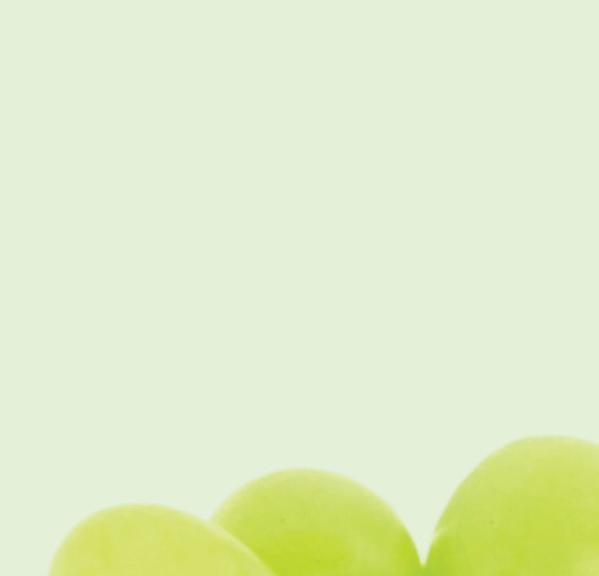
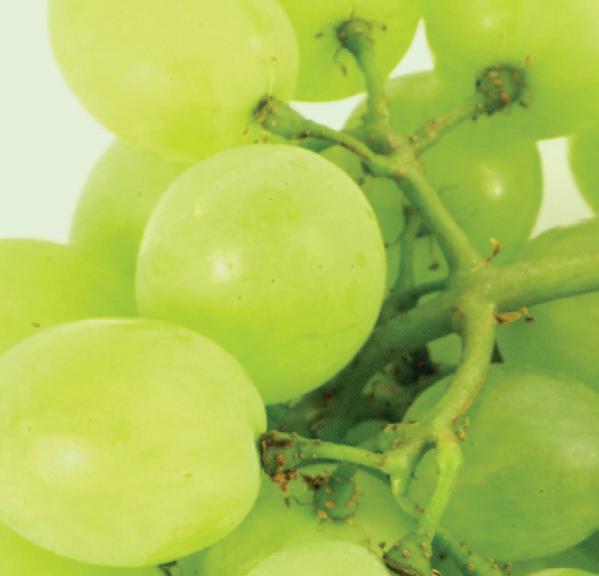


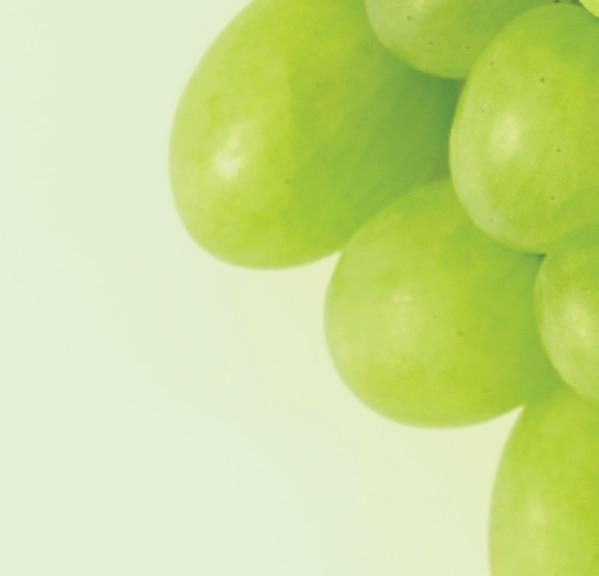

Demand in Europe and North America remained strong for Greek kiwifruit, says Youphoria Fruits’ George Kallitsis, as the campaign entered its final stages.
by Tom Joyce @tomfruitnetGreek kiwifruit was enjoying strong demand, according to George Kallitsis of Youphoria Fruits, as the country’s export season entered the last few weeks of a successful campaign.
Due to a lack of fruit from New Zealand and Chile last year, exports from Greece started earlier than usual. “In general, we exported more to overseas markets, which performed much be er this campaign,” said Kallitsis. “The Brazilian market has been going really well. We finished exports there this month, since production is now arriving from nearby Chile.”
In Brazil, harder fruit is preferred, he revealed, partly because of the huge size of the country. “The biggest quality issue is the pressure of the fruit,” he explained. “They like very hard fruit. It’s a big country and the transport network is not that strong, so they need tough fruit to handle the transit time from one part of the country to another.”
The European market has also been encouraging this year, according to Kallitsis. “Europe has been be er,” he said. “We are exporting at the moment mostly to Spain, Poland and to neighbouring countries such as Albania and Bulgaria, as well as some small volumes to the UK. These exports will continue later than overseas ones. We still have a stock of more than 1,000 tonnes, which will keep us in play till mid-May, with the majority sold by the end of April. Right now, our overseas exports are mainly to US and Canada, where demand is pre y strong.”
“We are gradually entering the market for golden kiwifruit. We are planting trials, such as of Golden Passion”
BELOW—Youphoria expects its kiwifruit exports to continue until mid-May

With production volumes of green kiwifruit still rising, Greece is expected to be the dominant player in the Northern Hemisphere in the coming years. But eyes are also on the golden variety, as its popularity grows.
“Greek production of green kiwifruit is around 300,000 tonnes, and that will rise to 450,000 tonnes in a few years, so Greece is becoming stronger,” said Kallitsis. “We are gradually entering the market for golden kiwifruit. We are planting trials, such as of Golden Passion. And we are waiting to see
if Zespri decides to start planting its Zespri Gold commercially in Greece.”
As the kiwifruit season winds down, Youphoria Fruits also ups its preparations for the cherry season. “The weather has been good,” said Kallitsis. “The winter was a bit warm, but the chilling hours should be enough. It’s a bit early to estimate the volume, but we’ve had no issues so far. Without doubt, it will be an early season, maybe one week earlier due to the higher temperatures. Hopefully we don’t have any bad surprises.” E
French association Interfel has been promoting the country’s apples across Asia this season, including a campaign in major cities in Thailand, a key market for French exporters.
by Tom Joyce @tomfruitnetInterfel, the association for fresh French fruit and vegetables, has been actively promoting French apples in Thailand this season, following a successful press event in Bangkok. The main activities around the promotion began in December 2023,
lasting until March this year.
These included 12 roadshows and 355 sampling sessions, organised with the main retailers in the country, including Big C, Makro, Lotus and Tops, focusing on Bangkok, Chiang Mai and other cities.


“Sampling, push selling and tasting took place to highlight and promote the diversity and quality of French apples to local consumers,” Interfel stated on LinkedIn. “Thailand is a key market for fresh fruits and vegetables, and Interfel has been active in this country for decades.”
The campaign forms part of a new programme co-financed by the EU to promote French fruits and vegetables all over Asia. E

ABOVE—An instore promotion for French apples in Bangkok





Verda Vivo Doo Novi SAD


The Port of Antwerp authority calls Certified Pickup an important step in the digitalisation of the logistics chain for containers.
by Tom Joyce @tomfruitnetPort of Antwerp has announced the completion of the last phase of the rollout of Certified Pickup (CPu) for container terminals before the locks.
“This digitalisation process is an important milestone for container transport to and from Antwerp,” Port of Antwerp authority stated. “Certified Pickup not only improves the safety of incoming containers but, as the first central platform, it also creates a transparent logistics chain.”
Preparations are apparently already underway to link the terminals behind the locks in Antwerp to CPu.
“Every day, truck drivers collect around 3,000 containers from the Antwerp port area,” the Authority revealed. “This process currently runs via one central information system. Certified Pick up is the first digital platform that connects safety and transparent communication. Thanks to CPu, developed by NxtPort, every link in the chain will receive prompt updates. This offers a range of benefits for each of the involved parties.”
Kurt Van Loon, project manager Certified Pickup, commented: “Certified Pickup is a game changer. The platform offers freight forwarders the option to dra
“This digitalisation process is an important milestone for container transport to and from Antwerp”
more accurate plans as they will know when a container will be unloaded. CPu is beneficial for transport companies because they will be immediately notified if they can’t collect a damaged container, for example. Therefore, they do not need to send unnecessary trucks to the port and can avoid additional costs. The system also prevents claims thanks to real-time information on the customs status. This transparent process is unique in the world.”
Safety is a core value for CPu, according to Port of Antwerp.
LEFT—Truck drivers collect around 3,000 containers daily from the Port of Antwerp area
Containers can only depart from the port in Antwerp by inland navigation ship, train or truck a er release by Certified Pickup. This is done on identity rather than pin codes.
“As a result, the platform can track which parties were involved in handling the container,” the Authority stated. “The system thus prevents abuse and increases general safety. The customs process is also completely transparent in CPu. A container may only leave the quay if customs has given it the green light.”
Willam Demoor, chief customer relations officer, commented: “The digital transformation of our ports is in full swing. With CPu, we have taken the first step and, together with the parties concerned, we will now see how we can improve the user interface. And this is just the beginning of our digital evolution, as we work together with the port community to ensure the efficiency and safety of logistics, based on the digitalisation pact of ‘The Way Forward’.”
Eric Verlinden, project manager at The Way Forward, added: “With The Way Forward, we are fully commi ed to developing a collective digital infrastructure in our port. As a representative of the port community, Alfaport Voka is taking an active role in collaboration with NxtPort and Port of AntwerpBruges. The digital platforms and applications we develop contribute to a more efficient and safer port. CPu is a great first example of how digitalisation can enhance the security of container handling in the port. As a second major project, we are now working hard on the Inbound Release Platform (IRP), a solution for the new PN/TS customs system that will further increase efficiency, security and transparency for all inbound cargo flows at the port.” E
The risk level remains ”elevated” in the region, the logistics group says, and routing around the Cape of Good Hope remains the “most reasonable solution”.
by Carl Collen @carlfruitnetMaersk has issued an update on the recent situation in the Red Sea, confirming in late March that the risk remained too high to resume sailing in the region.
It acknowledged that some other shipping lines continued sailing through the Red Sea despite security risks, while others had announced plans to resume sailing.
“Regretfully, both our internal analysis, as well as insight we received from external sources, still indicates that the risk level in the region remains elevated,” it stated. “We have seen a acks on commercial vessels increase in numbers, including the tragic a ack on the vessel True Confidence, which resulted in the death of three crew members, and the sinking of

The group also welcomed the “very positive development” of European Union security operation Aspides, which it hoped would increase safety and reduce the risk to vessels passing through the Red Sea and the Babel Mandeb Strait specifically. However, its analysis meant that it was not yet willing to change its current stance, Maersk said.
the vessel Rubymar, which is posing a serious environmental risk.
“These incidents unfortunately highlight the lethal effectiveness of missiles currently used by Houthi a ackers and are one of the reasons for the elevated security risk we have in place at the moment.”
The group said it respected the right of each carrier to make its
own decision about sailing through the region.
“At the same time, we continue with our own assessment that the current situation does not allow us to make a similar decision and with thus still believe that sailing via the Cape of Good Hope and around Africa is the most reasonable solution at the moment and the one that currently allows the best supply chain stability.
“Network changes are complex and take time to implement and we believe we should only implement such changes when they can be sustained over a longer period of time,” Maersk said. “We continue to
“We remain hopeful that resuming sailing through the Red Sea will become possible in the near future”
believe it is the only way to avoid further disruption under the current circumstances.”
The safety and wellbeing of its crews, the safety of vessels they were sailing on and the safety and integrity of its customers’ cargo being transported remained the utmost priority, the group noted.
“We remain hopeful that resuming sailing through the Red Sea will become possible in the near future and we are commi ed to providing our customers with regular updates on the developments,” Maersk added. E
vessels will continue to divert around the Cape of Good Hope
Plato once posed the philosophical question of why knowledge should be deemed more valuable than mere true belief. After all, the true belief that such a road is the way to Larissa will get you there just as well as concrete knowledge of the direction to Larissa. But if you know, rather than just truly believe, you’ll be less put off if the road initially heads in seemingly the opposite direction. Mere true belief, the Greek philosopher suggested, could well be lost at this critical juncture.
Approximately 2,400 years on, beliefs, true or not, are generally considered less worthy than knowledge. But the recent U-turns on aspects of the EU’s Green Deal and the glaring omissions in the recent FAO roadmap published at Cop28 show that knowledge evidently is not everything.

In the roadmap released in December, it is accepted that diets “absolutely must [change] for human and planetary health”. Yet its 120 actions do not include addressing the overconsumption of meat and dairy in developed countries, instead favouring increased efficiency of animal farming techniques.
“It’s very striking: the FAO doesn’t include one of the clearest interventions that would help meet both environmental and health targets,” said Cleo Verkuijl of the Stockholm Environment Institute US.
Scientists have shown the target to remain under 1.5C of warming cannot be met without major changes in food production. Animal farming produces 12-20 per cent of overall global greenhouse gas emissions and uses 83 per cent of farmland for just 18 per cent of our calories. But perhaps someone else truly believes something different.
It is partly this seeming absence of fact-based decision-making, coupled with a perceived lack of fairness, that has fuelled the farmers’ protests across Europe. The EU’s decision to row back on some evidence-based environmental targets will do nothing to assuage fears that true belief now trumps knowledge on the global stage.

Fresh, regional, modern. This is how the new Edeka Center hypermarket in Delmenhorst, near Bremen, presented itself when it opened in mid-April. The redesigned store offers a large selection of products, including plenty of local foods.
“We are pleased to be able to share our passion for food with our customers in Delmenhorst. You will be amazed by the wide range of goods, as well as the special atmosphere that the new market offers,” says manager Yusuf Caliskan, who has worked in the food retail sector for over 34 years.
The 4,500m 2 store features more than 40,000 individual items for sale. In its extensive fruit and vegetable department, shoppers can find local and seasonal products, as well as exotic fruit from Europe
and further afield. Its range of organic and regional products, as well as vegetarian and vegan items, has also been expanded. And at a large salad bar, customers can find salads freshly prepared on site every day.
Edeka Center Delmenhorst has evidently prioritised environmental sustainability. Energyefficient lighting and refrigeration systems minimise its environmental footprint. And by offering reusable net bags, it encourages customers to avoid single-use plastics and makes it possible to avoid using bags made from such material when shopping for fruit and vegetables. Moreover, the focus on local produce reduces transportation emissions and supports the continued development of regional farms. E
